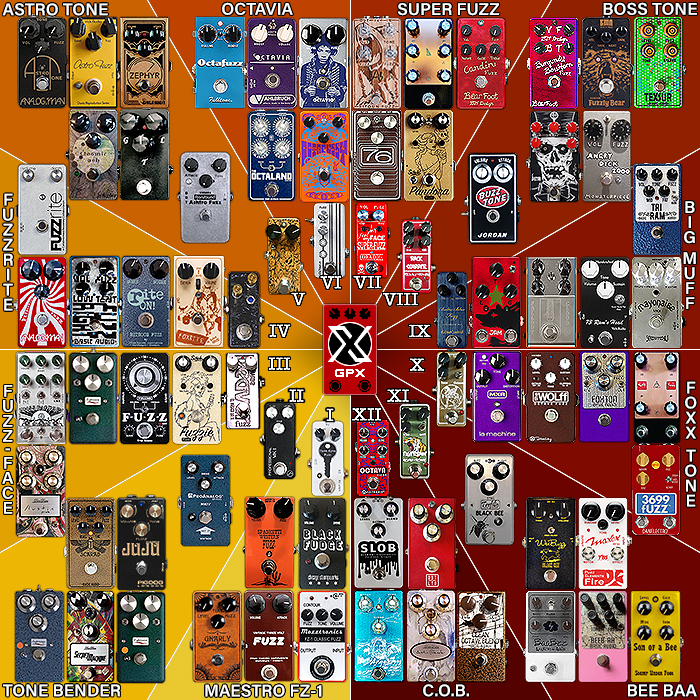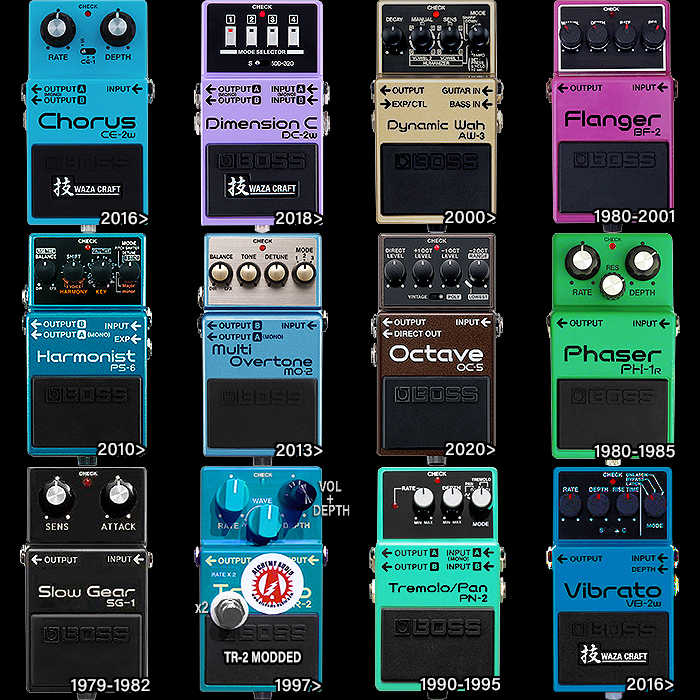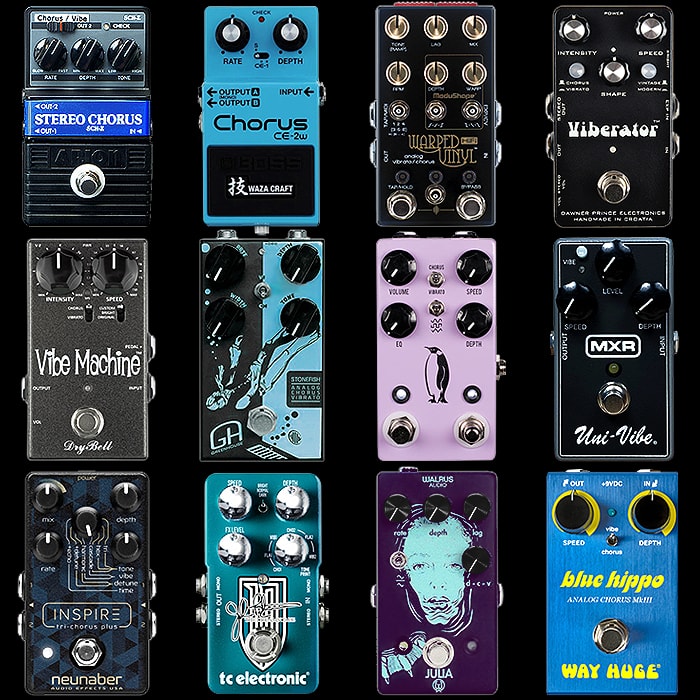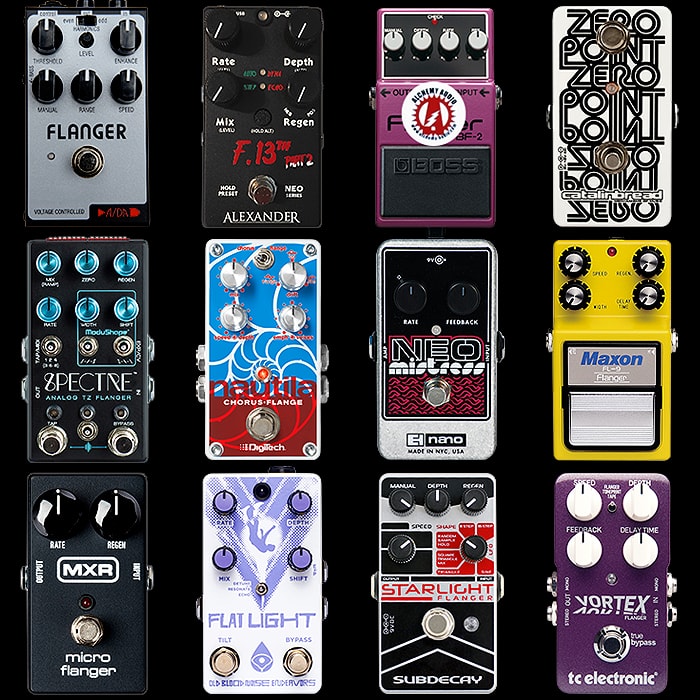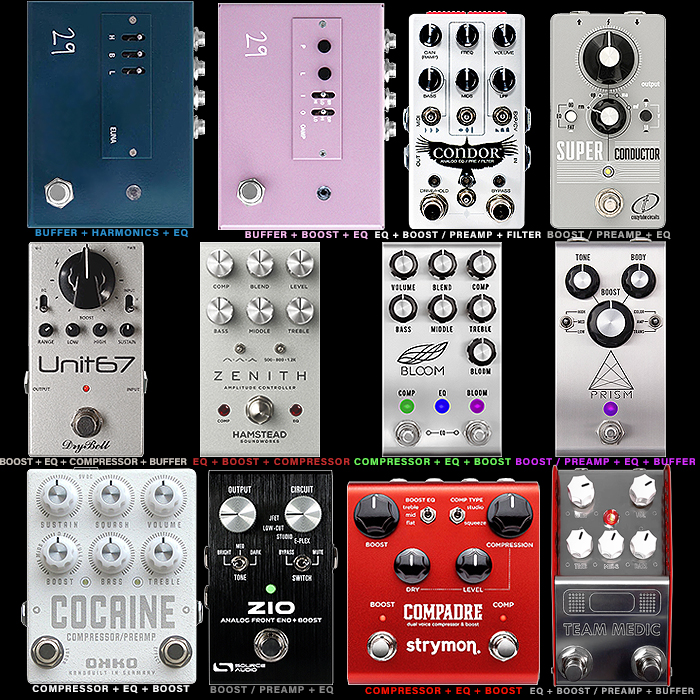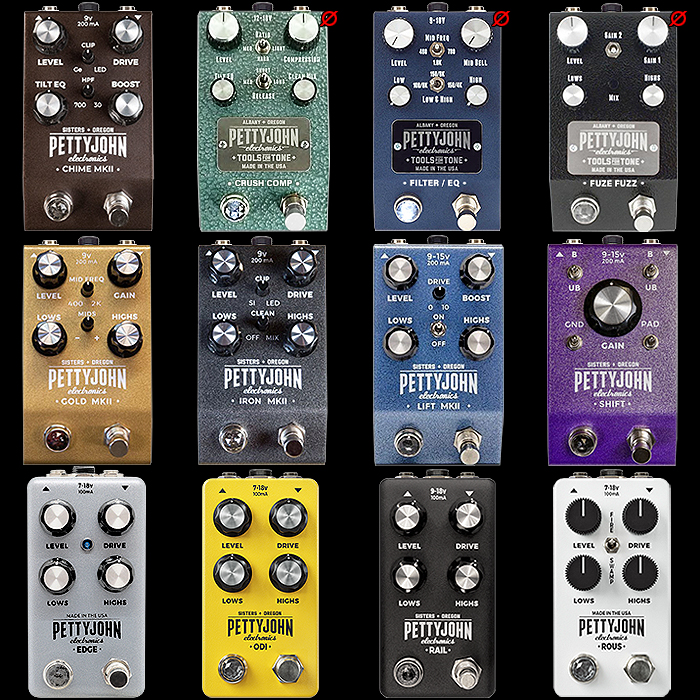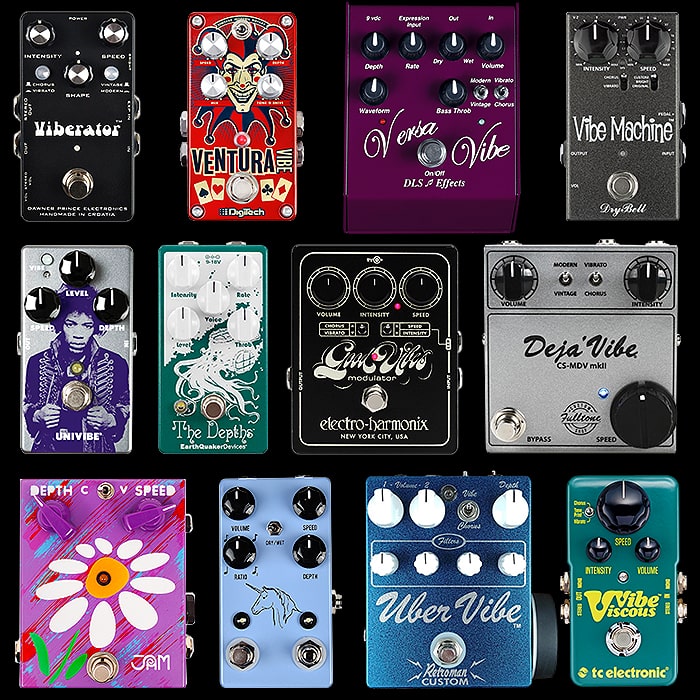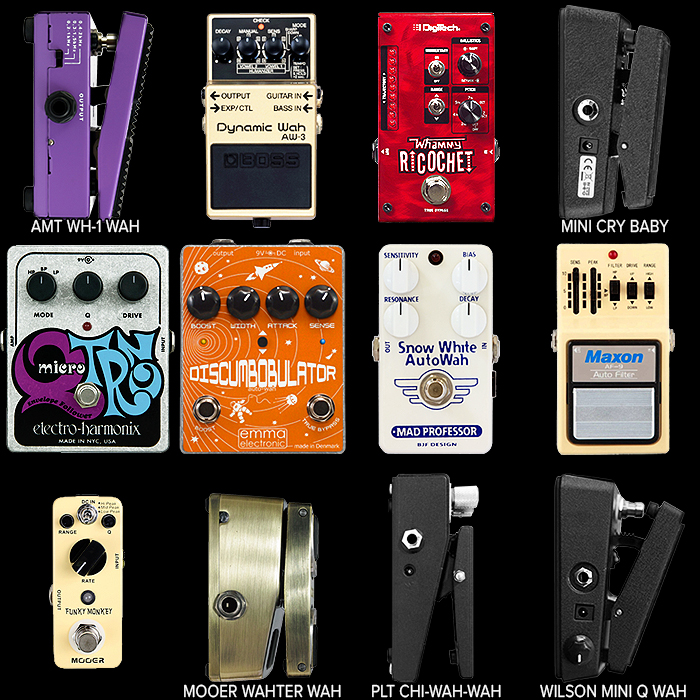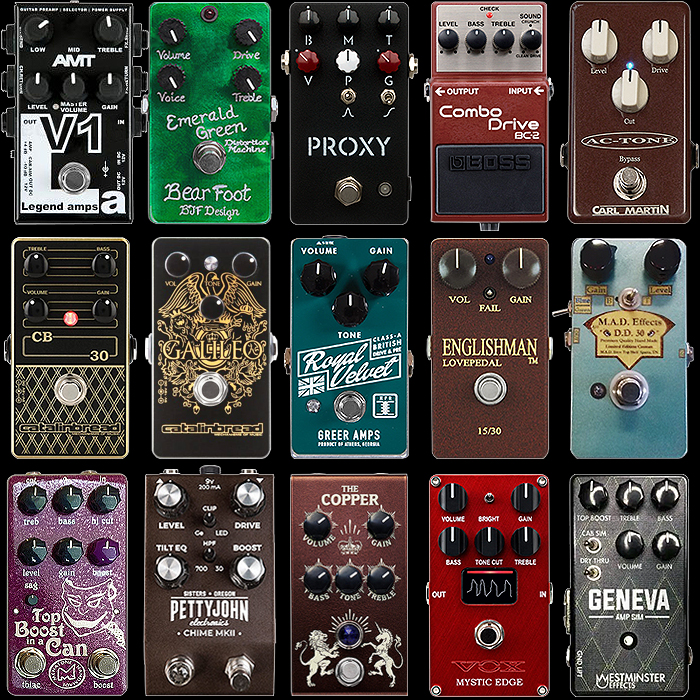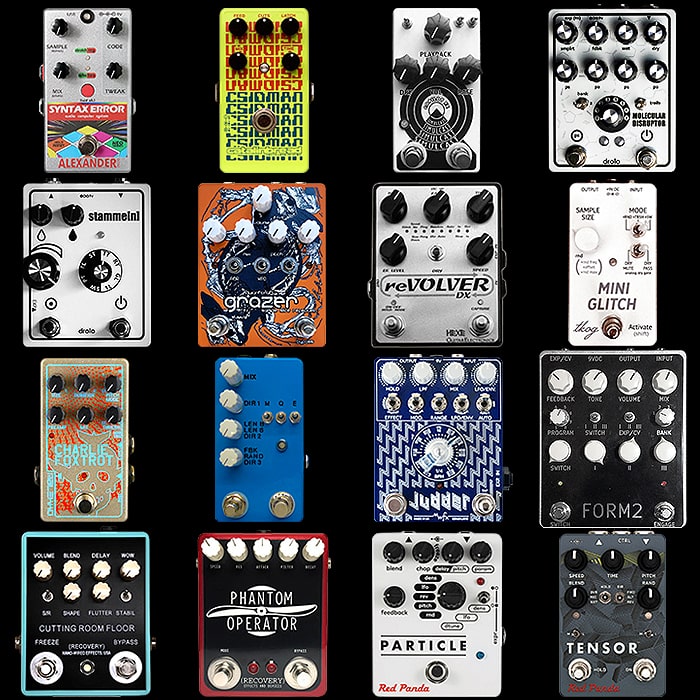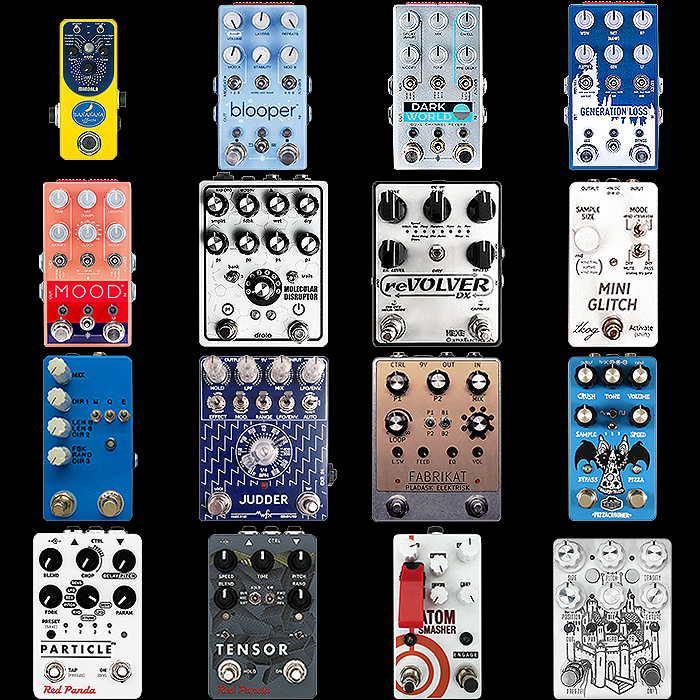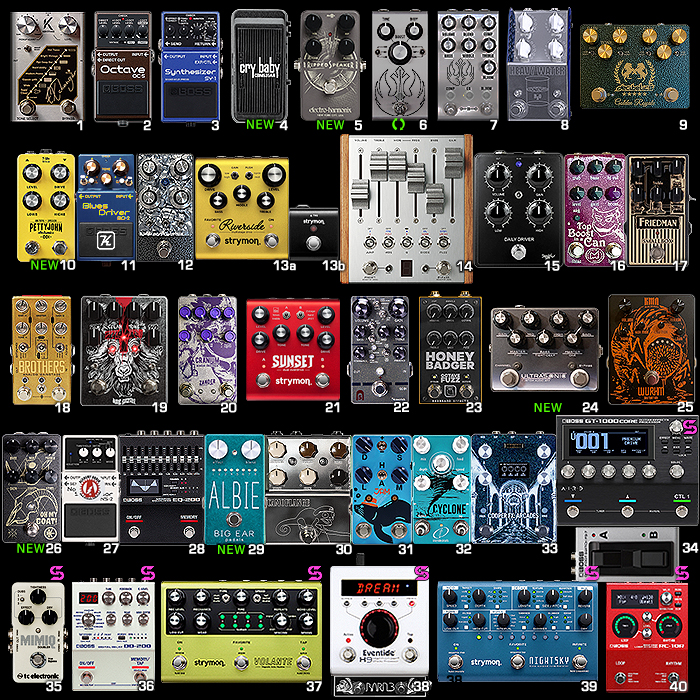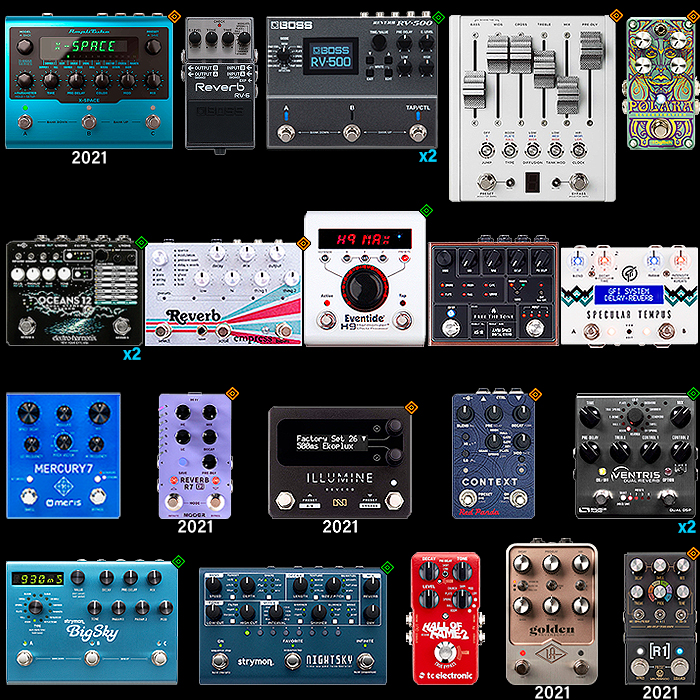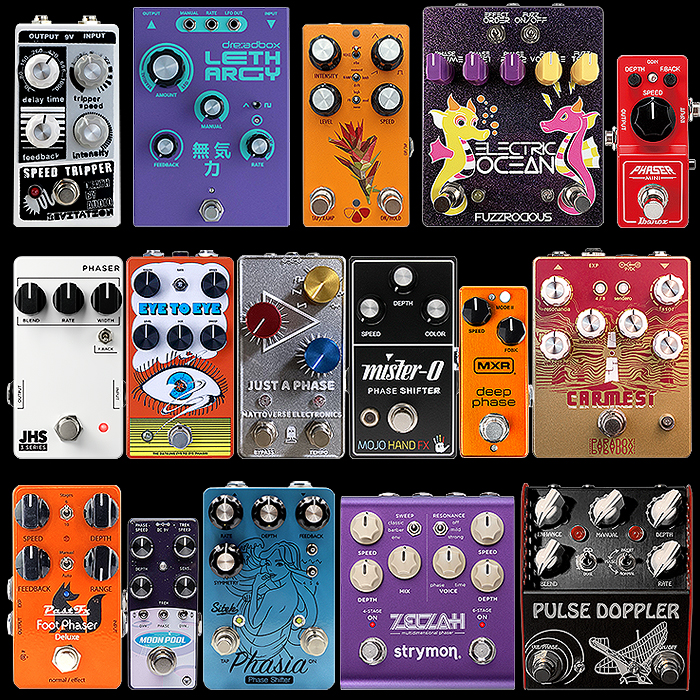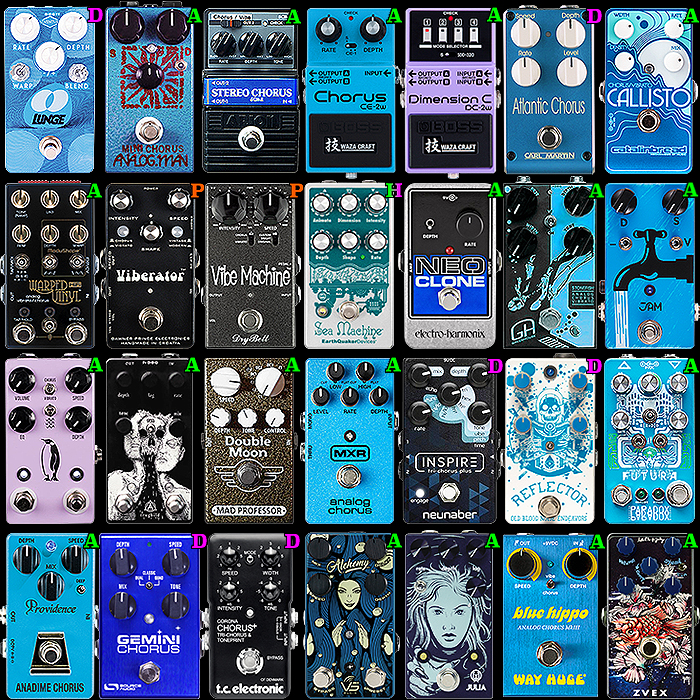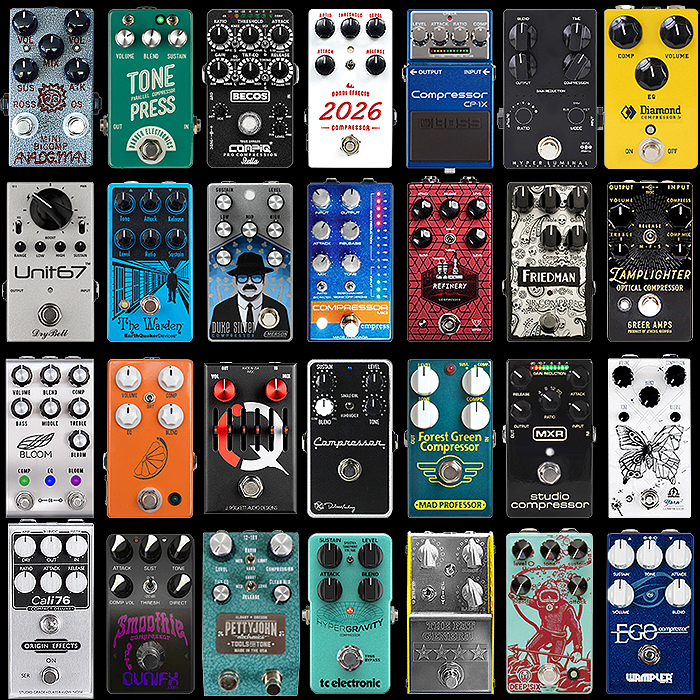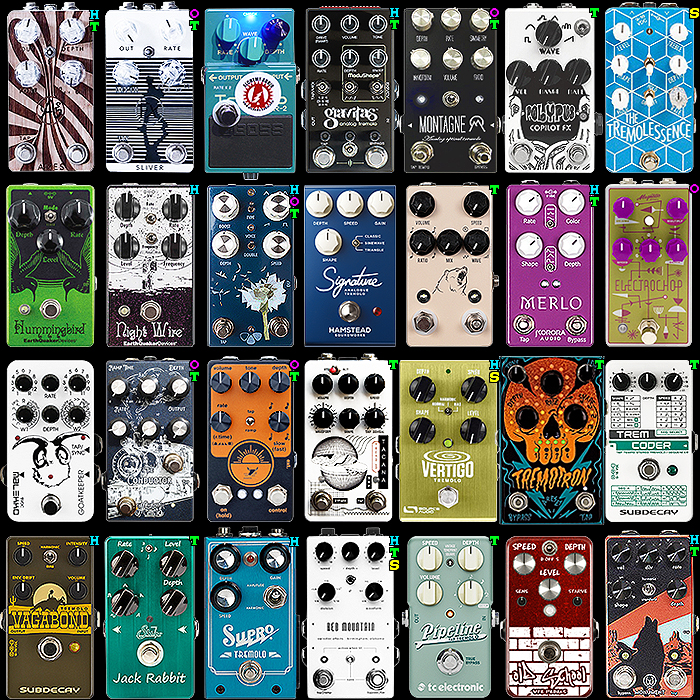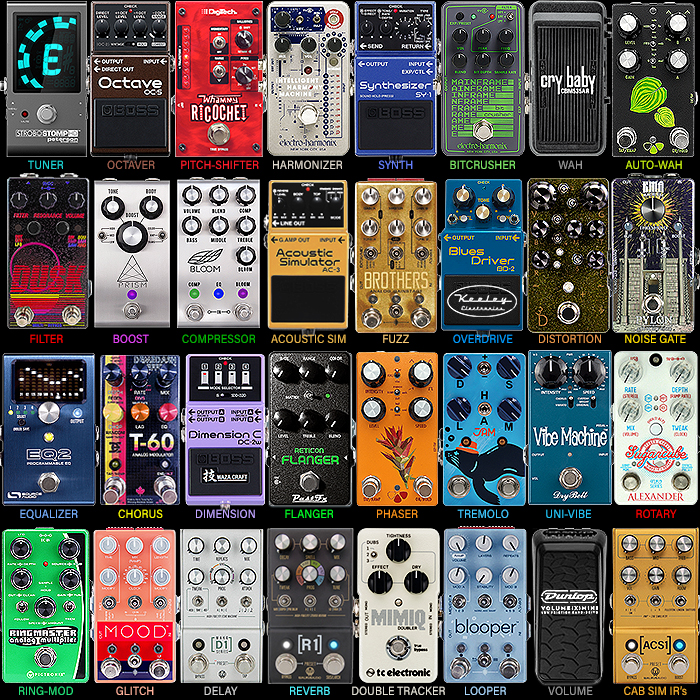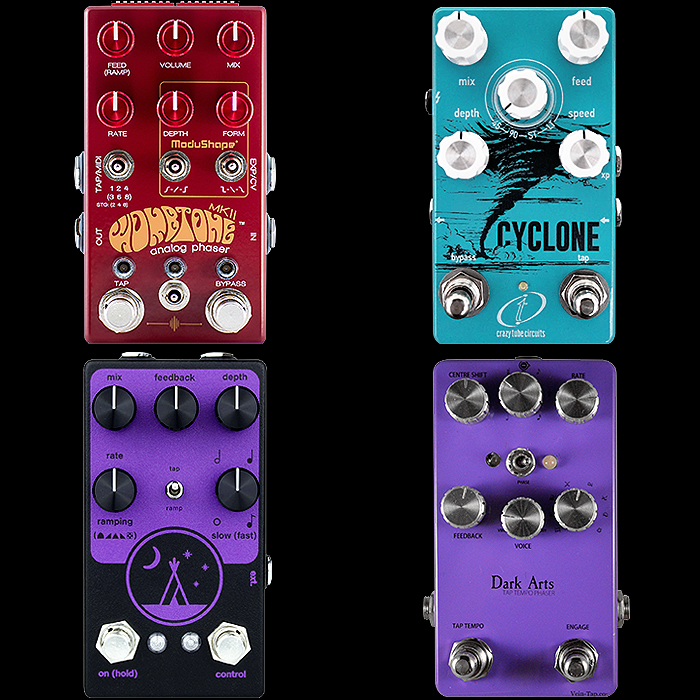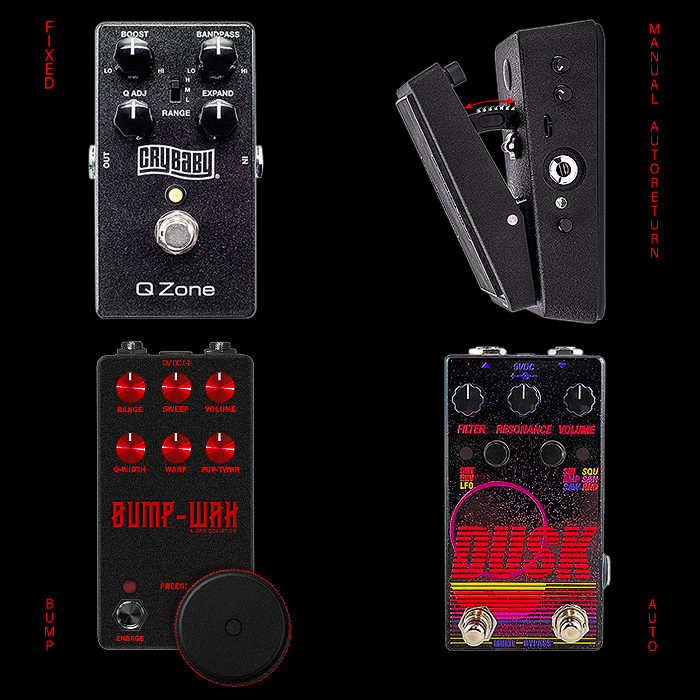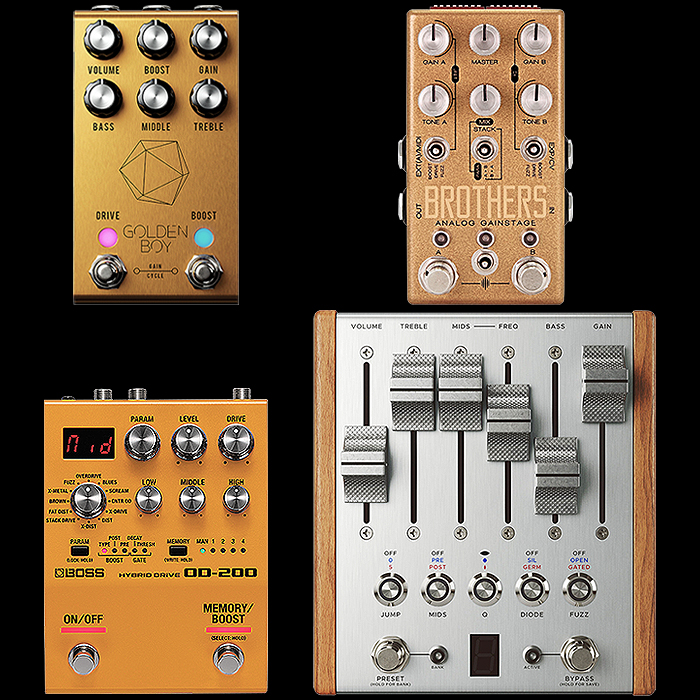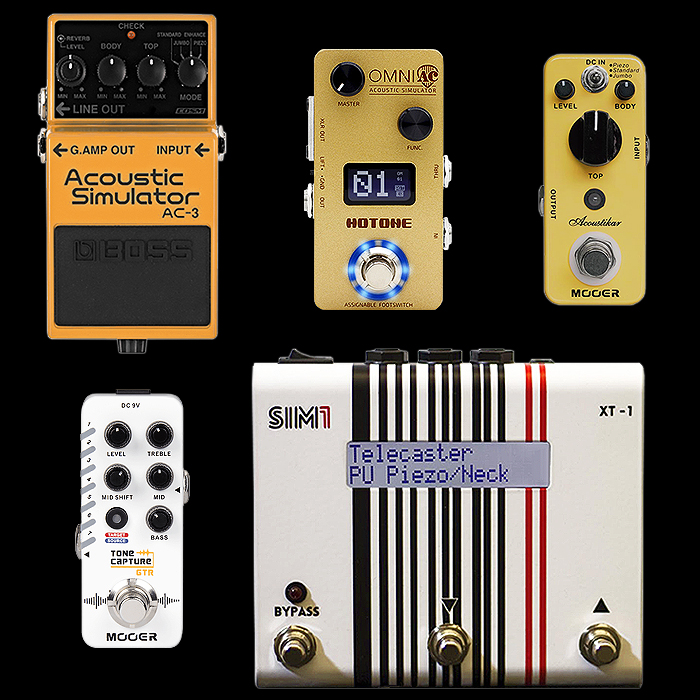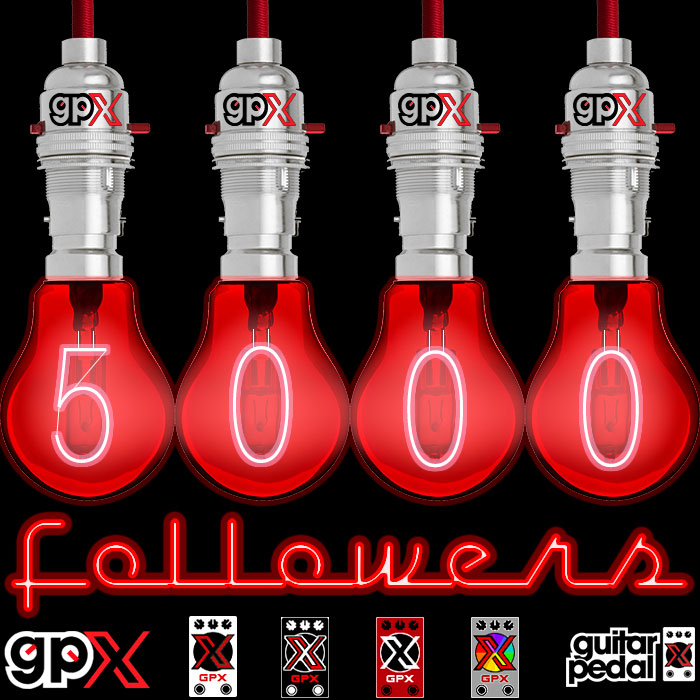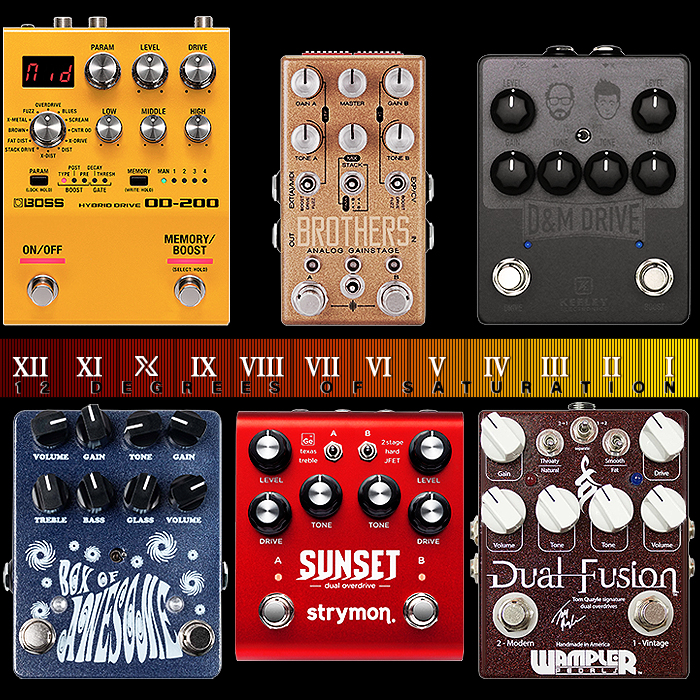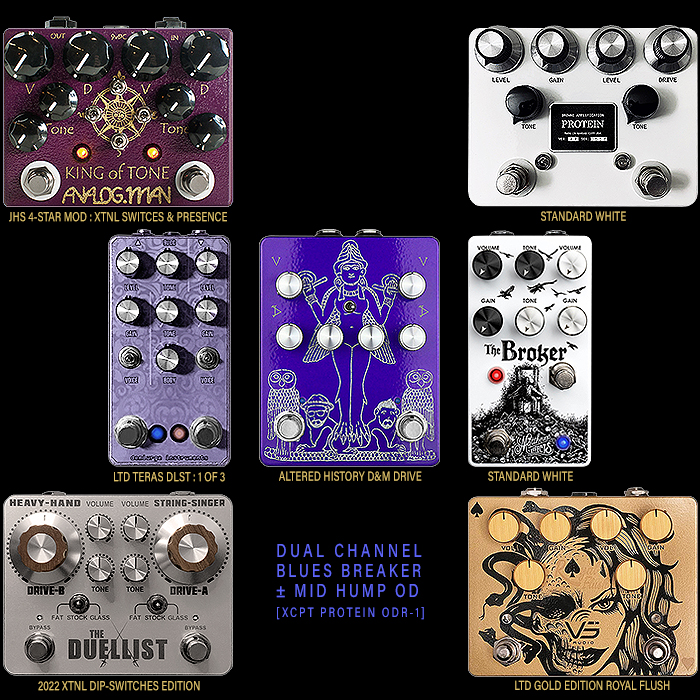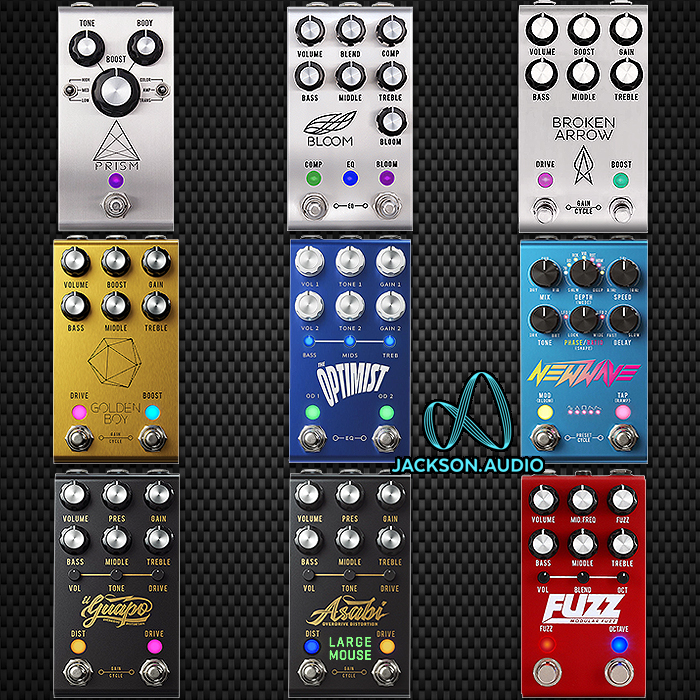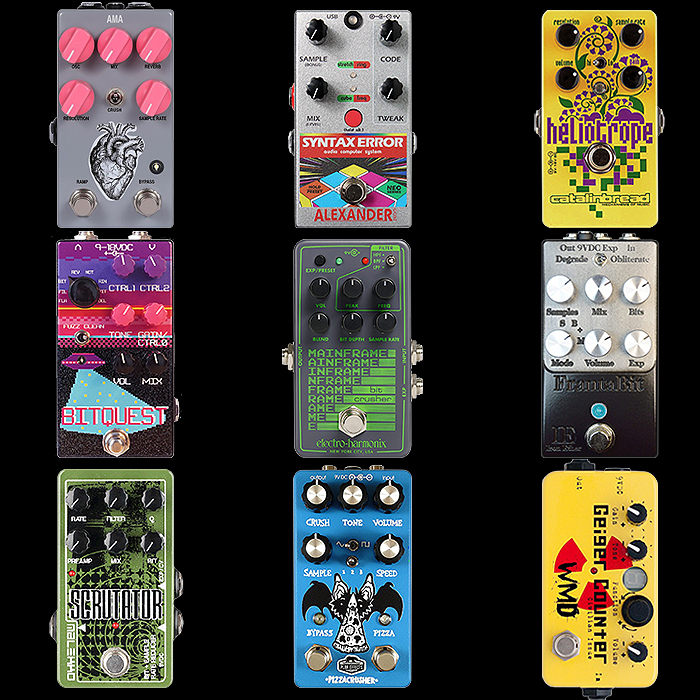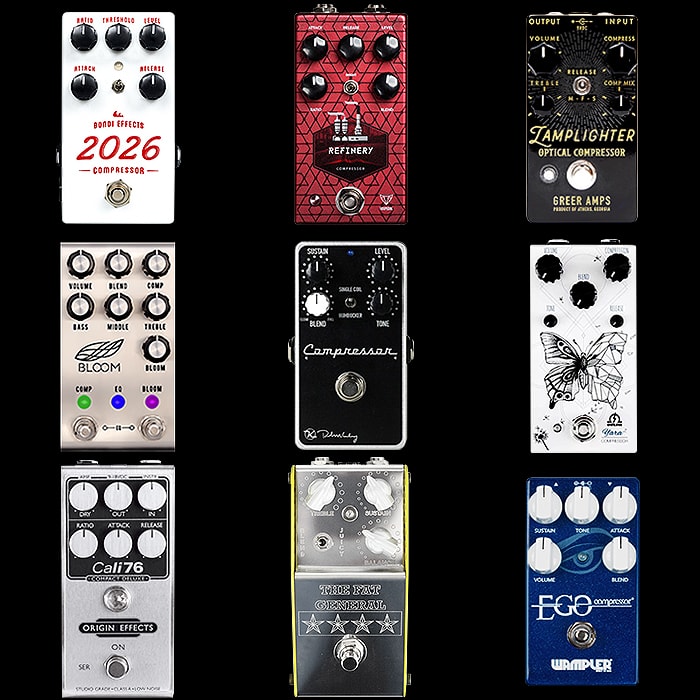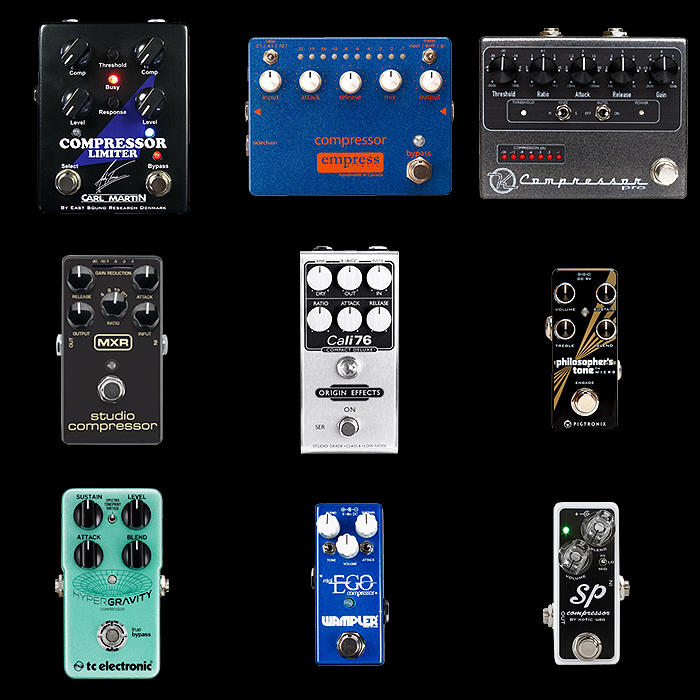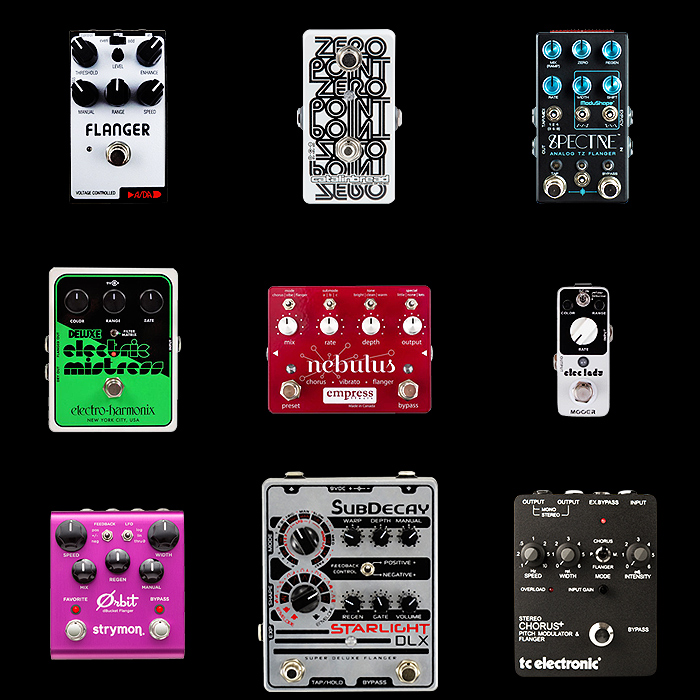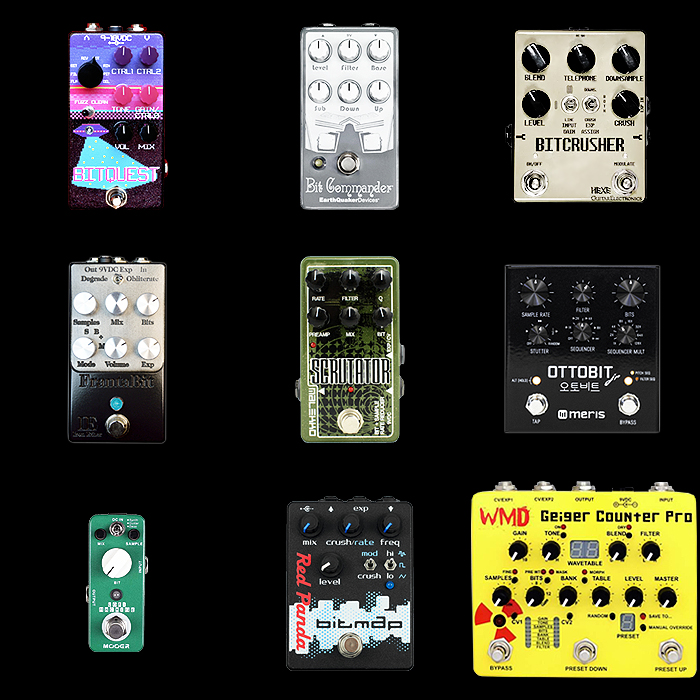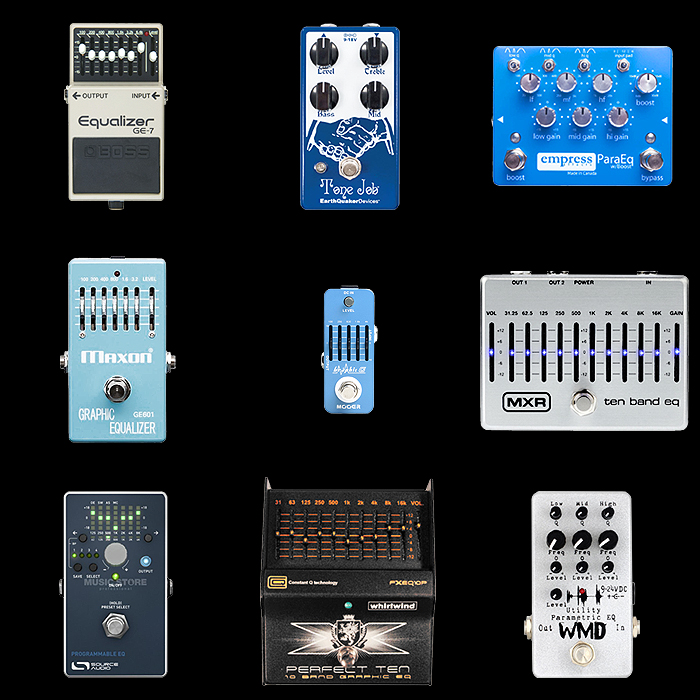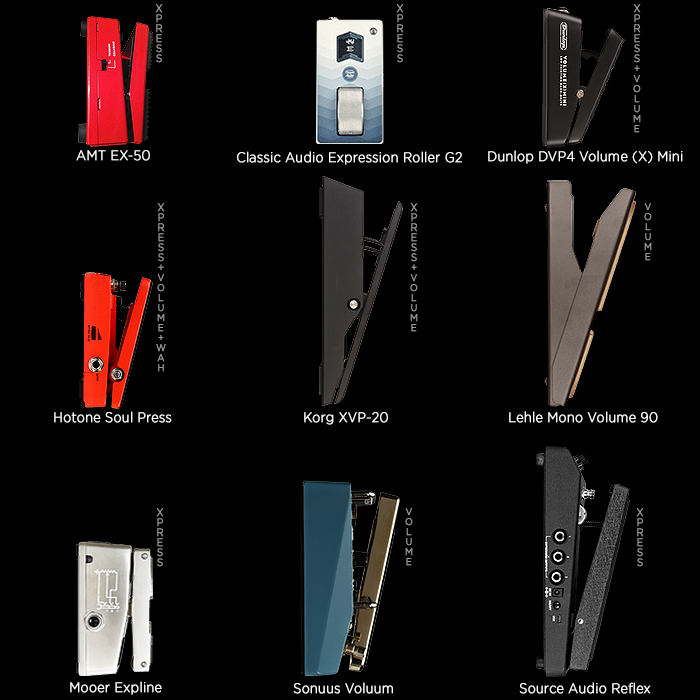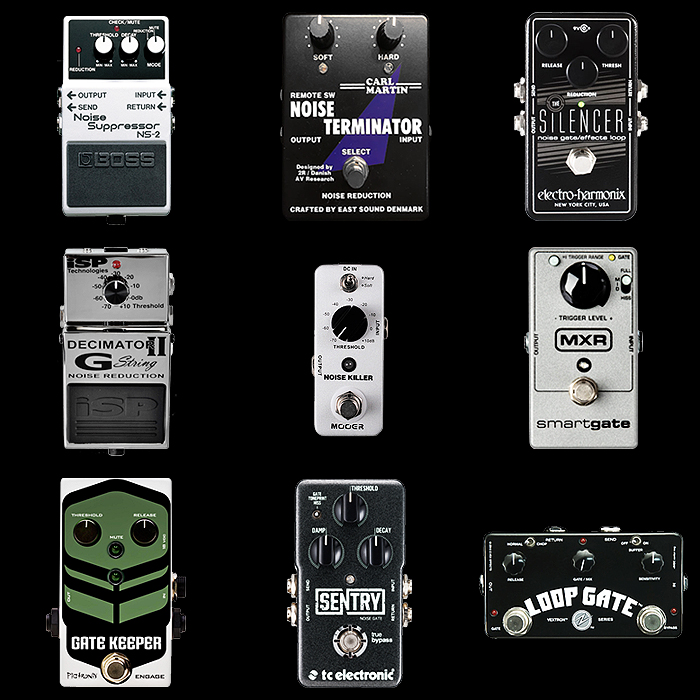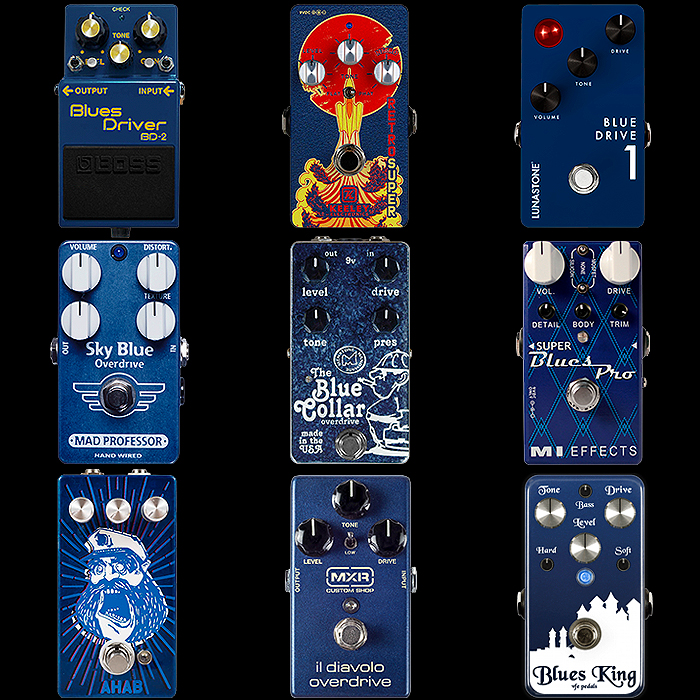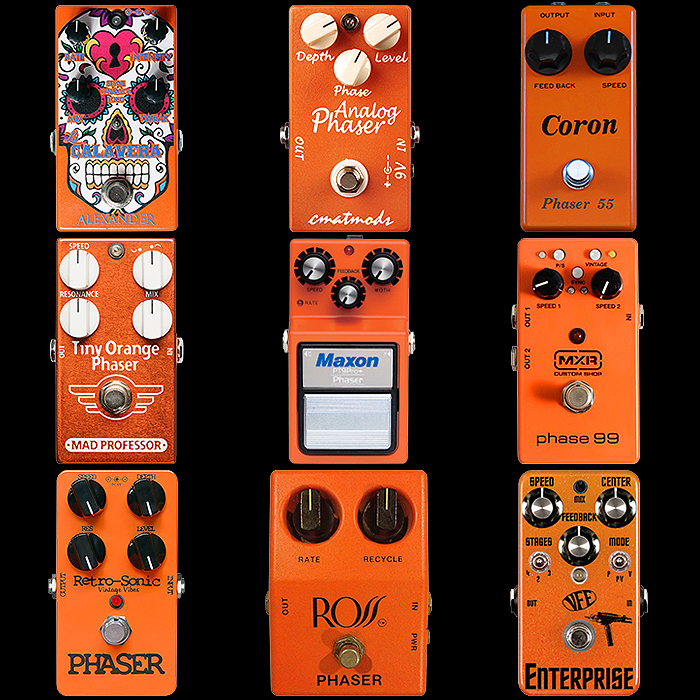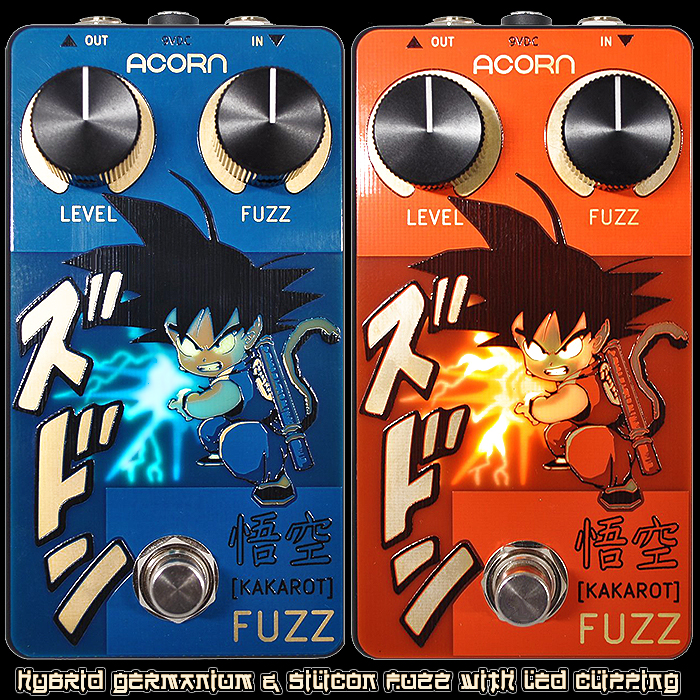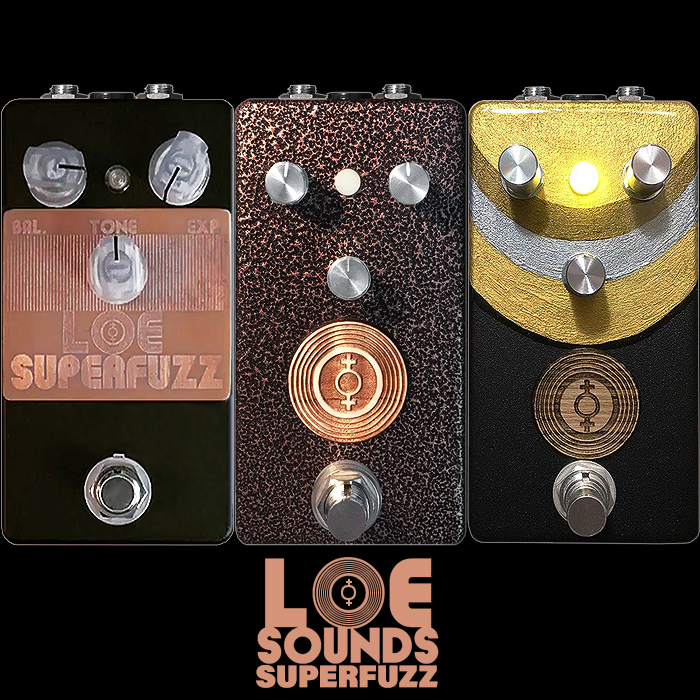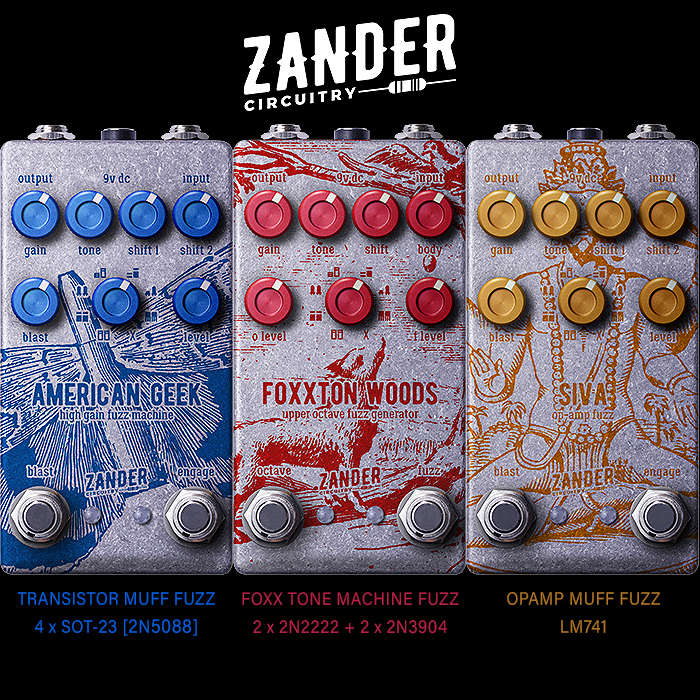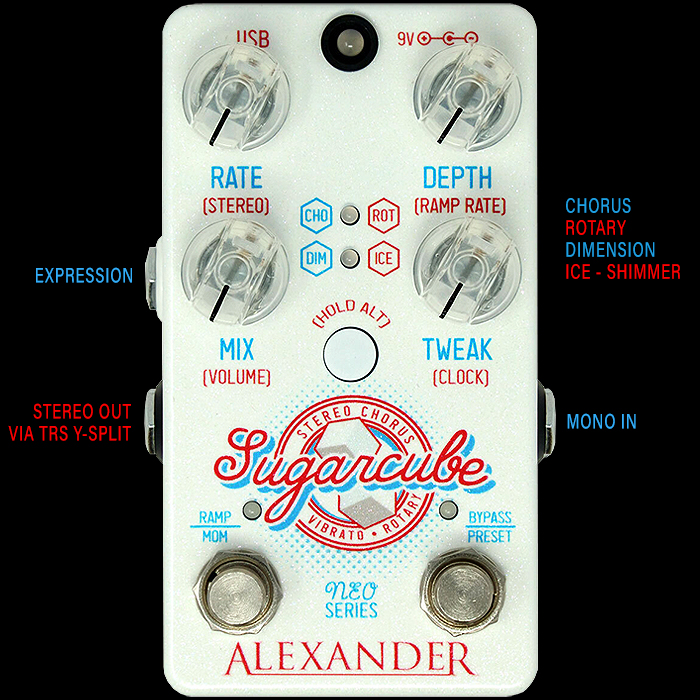32 Key Guitar Effects Pedal Types - Preferred Compact Pedal per Type
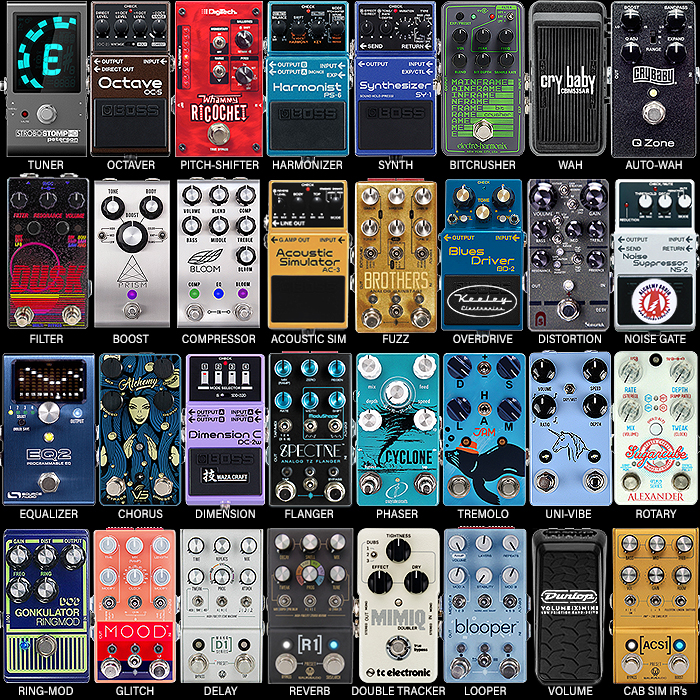
It was only natural that the Compact Format Preferred Versions feature should follow the Mini examples. Again largely inspired by the recent ’12 Degrees’ projects.
Once more I’ve had a change of mind on some of the candidates and the preferred examples are slightly different to those previous references. Obviously new pedals have arisen, and priorities and preferences can shift fairly regularly based on prevailing mood.
That said, most of these are long-term perennial favourites which have largely stood the test of time. Do note that my preferences may not exactly align with your own - which is why I have included the ’Decent Alternatives’ sections too. I get carried away with some of them with multiple examples, while I’m more restrained in other areas. Some varieties have lots of worthy and viable alternatives, while others have relatively few. Note that this is not supposed to be totally comprehensive - however broad its remit. I can’t support and favour every single brand there is - and so like most people - I may have a certain bias towards some brands - while the intention is always to be as objective and neutral as possible.
This is once more intended to punctuate and sign-post your journeys of discovery - and is not necessarily the end destination. You have plenty of time in any case to survey the options and choose which path best suits your preferences and circumstances.
Boss is still the king of Compacts for me - with 7 solid entries here, followed by Chase Bliss Audio with 4 mentions, and Dunlop/CryBaby/MXR and Walrus Audio with 3 apiece, and then a pair of Jackson Audio - and some singles.
When I did this exercise 4 years ago with 20 Types, Chase Bliss Audio and TC Electronic had 5 entries each, and then Boss had 4, with a pair of Dunlop/CryBaby/MXR’s and then singles.
I do hope you are able to make some use of this - it has certainly taken a quite a bit of effort to compile - in any case it should provide a handy guide for much of the best that is out there! :
TUNER : Peterson StroboStomp HD Compact - £120
For mini it's either or for me of PolyTune vs Turbo Tuner, while at the compact size I feel the latest Peterson StroboStomp is probably at the top of that pile. Of course Boss's TU-3 is a solid industry-standard choice too!
Decent Alternatives :
- Boss TU-3 Chromatic Tuner
- Sonic Research Turbo Tuner ST-300 Compact
- TC Electronic PolyTune 3 Tuner Noir
OCTAVER : Boss OC-5 Octave - £119
The OC5 is a fantastic update on two Boss classics and sounds very much to my liking in the OC-2 Mode. In the past I've had the Sub N Up or Mu-Tron Octavider in the top slot - while the new Boss does some clever things that those cannot. The OC-5 has controls for Direct Level, +1 Octave Level, -1 Octave Level and -2 Octave Level / Range. And you get a two way mode selector for Vintage (OC-2) and Polyphonic Modes.
Decent Alternatives :
- EarthQuaker Devices Bit Commander
- Electro-Harmonix Nano POG
- Mu-Tron Octavider Octave Divider
- TC Electronic Sub N Up Octaver
- T-Rex Quint Machine Octaver
PITCH-SHIFTER : DigiTech Whammy Ricochet Pitch-Shifter - £101
I had several close choices here, while the pedal I use most often in this area is indeed the Whammy Ricochet - and mostly to do that Tom Morello thing! Otherwise probably the Boss PS-6 Harmonist, EHX Pitch Fork or TC Electronic Brainwaves - also the recent Alexander Marshmallow is sweet too!
Decent Alternatives :
- Alexander Pedals Marshmallow Artificial Sweetener Pitch Shifter
- Boss PS-6 Harmonist Pitch-Shifter and Harmonizer
- DigiTech Drop - Drop-Tuner
- EarthQuaker Devices Pitch Bay
- Electro-Harmonix Pitch Fork
- TC-Electronic Brainwaves Pitch-Shifter
HARMONIZER : Boss PS-6 Harmonist Pitch-Shifter and Harmonizer - £129
I own the TCE Quintessence which I find some fiddly and frustrating - same as its Brainwaves sibling - which is why I swing towards the Boss PS-6 which is rather more easy and effortless - while it doesn't have the Quintessence's TonePrints and more complex modes. The pedal I mostly deploy in this role is actually the medium-box Meris Hedra. While for compact - the PS-6 would be my choice. It has controls for Balance / Rise Time, Shift / Harmony, Key ' Fall Time, and Modes.
Decent Alternatives :
TC Electronic Quintessence Harmonizer
SYNTH : Boss SY-1 Synthesizer - £175
I have a number of favourite compact Synth Pedals - including of course the hugely versatile SU-1 with no less than 121 total algorithms. In the past the DigiTech Dirty Robot and Pigtronix Mothership 2 have been top dogs - while I really need to start adding one or two of those Subdecay Synths to the collection too - same for Alexander Pedals really. The SY-1 has two dual-concentric knobs out of 4 - for 6 parameter controls overall - Effect Level, Direct Level, Tone/Rate & Depth, 1-11 Variation and 1-11 Modes/Types.
Decent Alternatives :
- Alexander Pedals Colour Theory 8-Step Sequencer/Modulator
- DigiTech Dirty Robot Stereo Mini-Synth
- Pigtronix Mothership V2 Analog Synthesizer
- Source Audio C4 Synth
- Subdecay M3 Monophonic 3 Oscillator Guitar Synth
- Subdecay Octasynth
- Subdecay Octave Theory Octave Modulator / Synthesizer
BITCRUSHER : Electro-Harmonix Mainframe Bitcrusher - £165
The one I'm actually most after here isn't a proper Bitcrusher at all really - the Catalinbread Heliotrope. While the recent EHX Mainframe probably has the most impressive feature set overall of those current ones - where I'm still chasing down a number of these - including a WMD Devices Geiger Counter - where I keep changing my mind on whether I should get the Compact or Medium enclosure edition. The EHX Mainframe has no less than 8 controls - Expression/Preset button, HPF/BPF/LPF Filter, Volume, Peak, Frequency, Blend, Bit Depth, and Sample Rate.
Decent Alternatives :
- AC Noises Ama V2 Reverb with Oscillator and Bitcrusher
- Alexander Pedals Syntax Error Audio Computer System
- Catalinbread Heliotrope Harmonic Pixelator
- Dr Scientist BitQuest Multi-FX and Fuzz Modulator
- Iron Ether FrantaBit Sample Rate / Bit Reducer
- Malekko Scrutator Sample Rate and Bit Reduction Pedal
- Source Audio Ultra Wave Multiband Processor
- WMD Devices Geiger Counter Civilian Issue High Gain Preamp, 8 Bit Computer and Bitcrusher
WAH : CryBaby CBM535AR Mini Auto-Return Wah - £159
I've always loved the Mini CryBaby and Dunlop treadle pedals - with their properly compact form factor. Some of those WAH pedals are just monstrous in size and totally dominate a pedalboard. I love the convenience of the spring-loaded Auto-Return / Auto-Switching Wah of the latest edition - while you can't do the cocked Wah thing with that type. I may still get a few more Mini-Wahs along the way - likely the Chi-Wah-Wah and one of the Wilson Mini-Wahs. The CBM535AR has the exact same controls as the 535Q version that I also have - a boost switch with level, then 4-way Range-Selector and Q-Adjust.
Decent Alternatives :
- AMT Electronics WH-1 Optical Wah-Wah
- CryBaby CBM95 Mini Wah
- CryBaby CBM535Q Mini Auto-Return Wah
- Dunlop/CryBaby Hendrix JHM9 Mini Wah
- Plutoneium Chi-Wah-Wah
- Wilson Effects Mini Freaker Wah
- Wilson Effects Mini Q-Wah
AUTO-WAH : CryBaby CSP030 Q-Zone Auto-Wah - £159
I actually use two Fixed / Auto-Wahs quite regularly - the medium-sized Fulltone Wahful, and the referenced Custom Shop CSP030 edition of Q-Zone with extended controls. The full-fat Q-Zone has 5 controls - Boost, Bandpass, Q-Adjust, Expand, and 3-way Range Selector.
Decent Alternatives :
- Boss AW-3 Dynamic Wah
- CKK Q Cat Auto Wah
- Lovepedal Organic Grooves Auto Wah (discontinued)
- Mad Professor Snow White Auto Wah
- Maxon AF-9 Auto Filter
- Tone City Funny Boy Auto Wah
FILTER : Dr Scientist Dusk Dynamic Filter - $199
My go-to Filter and Auto-Wah pedal is really the Dr Scientist Dusk which I love for its easy versatility and smart playability. I also fully intend to pick up a Flower Pedals Hosta at some stage, and the somewhat larger format Spaceman Effects Artemis Modulated Filter. The Dusk has a really smart dual-footswitch control topology with knobs for Filter, Resonance and Volume, and selector push-buttons for Mode and Function / Sub-Mode.
Decent Alternatives :
- Analog.Man Block Logo Envelope Filter
- Flower Pedals Hosta Analog Wah Filter
- Mu-Tron Micro-Tron III/IV Envelope Filter
- Pigtronix Resotron Analog Tracking Filter
- Source Audio Spectrum Intelligent Filter
- VFE Mini Mu Filter
BOOST : Jackson Audio Prism Boost + Buffer + EQ + Preamp - £249
Despite my desire to not promote Jackson Audio in the slightest, it cannot be avoided in a couple of instances as there just isn't any direct equivalent that renders the same results. I've tried various alternatives here in an attempt to display the Prism - but that pedal has a warmth, softness and sustain to it that I've hitherto been unable to replicate elsewhere. I had the ThorpyFX Team Medic on this slot for quiet a while - which by default delivers a slightly brighter and more articular tone - where I've discovered that the Prism is actually a core component of my own signature sound. I would like it to be a little more like it's siblings - with a second footswitch and some smart foot-manipulation like the Bloom - yet it is largely and comparatively relatively traditional compared to those - as least in terms of live playback. The Prism has 5 elegant controls - Boost, Tone and Body knobs, and 3-way Gain and Boost Type Switches - for 3 modes Color / Treble Booster, Amp/Preamp, and Transparent/Clean.
Decent Alternatives :
- Brian May Guitars Treble Booster Classic
- Chase Bliss Audio Condor Analog Boost + EQ + Preamp + Filter
- Chase Tone Secret Preamp Boost
- Expresso FX Germanium Boost OC44 Mojo Edition
- Fortin Blade Whitechapel Signature Boost
- Friedman Buxom Betty Boost
- Hamstead Soundworks Zenith Amplitude Controller Boost + EQ + Compressor
- JAM Pedals Rooster CV7003/OC44 Treble Booster
- KMA Audio Machines Strokkur AC125 Germanium Treble Booster
- Laney Black Country Customs SteelPark Boost
- Laney Black Country Customs Tony Iommi Signature Boost
- Maxon DB-10 Duall Booster
- SoloDallas Storm Boost
- Stone Deaf FX QBoost Dual Boost
- ThorpyFX Heavy Water Dual Boost
- ThorpyFX Team Medic Boost + Buffer + EQ + Preamp
COMPRESSOR : Jackson Audio Bloom Compressor + EQ + Swelling Boost - £315
This is another I unsuccessfully tried to unseat - but there is nothing out there with the same smart footswitch controllability over Compressor Modes, EQ, and Swelling Boost. Nearest equivalents are the Hamstead Zenith Amplitude Controller and DryBell Unit67 - but neither of those gets quite close enough. It's really about the granularity of application of those three functional modes on-the-fly. While if I just wanted a pure studio-style compressor, then I would likely go for the Becos FX CompIQ Stella Pro! The Bloom has 7 controls to go with its dual footswitches - Blooming Boost, 3-Band EQ, and Volume, Blend and Compression.
Decent Alternatives :
- Analog.Man Mini Bi-Comp Dual Mode Compresso
- Becos FX CompIQ Stella Pro Compression Pedal
- Bondi Effects 2026 Compressor
- Boss CP-1X Multiband Compressor
- Darkglass Hyper Luminal Compressor
- Diamond Pedals Comp Jr Optical Compressor
- DryBell Unit67 Compressor + EQ + Boost
- EarthQuaker Devices The Warden V2 Optical Compressor
- Empress Effects Compressor MKII
- Foxpedal Refinery V2 Compressor
- Friedman Sir-Compre Optical Compressor
- Greer Amps Lamplighter Optical Compressor
- Hamstead Soundworks Zenith Amplitude Controller Boost + EQ + Compressor
- JHS Pulp N Peel Compressor V4
- J Rockett IQ Multiband Compressor
- Keeley Compressor Plus
- MXR M76 Studio Compressor
- Ohmless Pedals Yara V2 Optical Compressor
- Origin Effects Cali76 Compact Deluxe
- Hamstead Soundworks Zenith Amplitude Controller Boost + EQ + Compressor
- Pettyjohn Electronics Crush Compressor
- TC Electronic Hypergravity Multiband Compressor
- ThorpyFX The Fat General Parallel Compressor
- Walrus Audio Deep Six V3 Compressor
- Wampler Ego Compressor
ACOUSTIC SIMULATOR : Boss AC-3 Acoustic Simulator - £100
Obviously we have the new Hotone variety for the Mini selection. I find it slightly odd that there aren't any more modern equivalents here - something like the Hotone with a screen and a couple or more controls - EQ etc. As it is the Boss AC-3 has become quite a traditional pedal and the only game at this enclosure size level as far as I can discern. The AC-3 has on dual-concentric knob of 4, for a total of 5 controls - Reverb, Level, Body, Top and Mode.
Decent Alternatives :
- None Known! Please Suggest!
FUZZ (Multi-Voice) : Chase Bliss Audio Brothers Gain Stage - discontinued - £349
So I currently have more than 270 fuzzes in my collection - so it's not really about ranking those to preferences, but rather identifying which of those are the most versatile Multi-Fuzz style varieties - i.e. deliver some significant variety in voicing - either via Mode switch or multiple controls. So this is really a Multi-Voice / Multi-Fuzz category - where I can't think of anything more handy than the alas now discontinued Chase Bliss Audio Brothers - which gives you the widest range of fuzz voicings in the one box that I'm aware of. Some Brothers owners use it mostly as a Drive pedal - while I always have at least one Fuzz voicing active on one of it's two channels - and often both. The Brothers has 10 main controls + those 16 dip-switches on the top age. The key controls are Gain A and Tone A, Gain B and Tone B, Master, 3-way Boost/Drive/Fuzz selector for each channel, Stacking Options, A/B Mix, and 3-way Presets Toggle switch.
Decent Alternatives :
- Basic Audio Scarab Deluxe Multi-Bender
- BO Effects TPC vs JRV
- Boss FZ-5 Fuzz
- Chase Bliss Audio Bliss Factory
- DOD Carcosa Fuzz
- Doxasound Deluxe Beetle Fuzz
- Dr Scientist Bit Quest Fuzz Modulator / Multi-FX
- Dr Scientist Frazz Dazzler
- Catalinbread Katzenkönig Fuzz
- Catalinbread Giygas Fuzz
- Crazy Tube Circuits Constellation Multi-Fuzz OC41
- Crazy Tube Circuits Constellation Multi-Fuzz OC44
- Fjord Fuzz Embla Fuzz
- Function F(x) Clusterfuzz Jr
- JAM Pedals Eureka Fuzz
- JHS Muffuletta Multi-Muff Fuzz
- Kuro Custom Audio Akuma Fiery Fuzz
- Magnetic Effects White Atom Fuzz
- Paul Trombetta Bone Machine GTX
- Pettyjohn Electronics RAIL Fuzz
- Redbeard Effects Honey Badger Sub-Octave Fuzz
- Shift Line Termofuzz
- ThorpyFX Fallout Cloud Fuzz
- ThorpyFX Field Marshal Fuzz
- Vemuram Myriad Fuzz
- Zander Circuitry Siclone Silicon Chaos Initiator
OVERDRIVE (Versatile) : Boss BD-2 Blues Driver Keeley Freak Fuzz Edition - discontinued / rare - c£250 equivalent for pristine copies
Everyone knows by now that my favourite overdrive of all time is the Keeley Freak Fuzz Modded Boss BD-2 Blues Driver. This pedal is just magical for me - and does that really smart gain cleanup with your Guitar volume knob - much like a Germanium Fuzz Face. Mine is distinct in having those external Germanium Transistors which are used as clipping diodes for the 'Freak Fuzz' mode. By default I have mainly the Phat Mod deployed - via right-hand switch, where the left-hand switch additionally activates the Germanium Transistor Clipping. Other than those two switches - it's just the same core 3 Level, Tone and Gain knobs. I get amazing range and textures here and actually one of my favourite Marshall-style texture with gain around 1 / 2 o'c. Boss's own BD-2W Waza Craft Edition is pretty decent - but it really doesn't get close to the magic of this one. I'm generally a big fan of Keeley's Boss Mods. My Demon Kondo-Shifuku is of course another perennial favourite, and I'm really enjoying my new Pettyjohn ODI Classic Mods, and Zander Circuitry Surplus Overdrive - while of course I too recommend all varieties of Decibelics Golden Horse - albeit none of those are of compact dimensions! My favourite Blues Breaker is probably still the Wampler Pantheon!
Decent Alternatives :
- Aleks K Honey Moon 2 Sweet Overdrive
- Anasounds Cerberus Custom Overdrive
- Bearfoot FX Sparkling Yellow Overdrive
- Bearfoot FX Uber Bee Overdrive
- Chase Bliss Audio Condor Analog Boost + EQ + Preamp + Filter
- Demedash 112+ Drive Channel
- Demon Pedal Kondo-Shifuku D-Style Drive
- DOD Looking Glass Glassy Overdrive
- Foxpedal Kingdom Combo V2 Overdrive + Boost
- Foxpedal The City V2 Overdrive + Boost
- Friedman Dirty Shirley Overdrive
- Hamstead Soundworks Odyssey Intergalatic Driver
- Jackson Audio Broken Arrow Overdrive + Boost
- Jackson Audio Golden Boy Overdrive + Boost
- JHS Pedals Bonsai Multi-Screamer
- J Rockett Melody Overdrive
- J Rockett Rockaway Archer Overdrive
- Kuro Custom Audio P.h.A. Overdrive
- Mad Professor Sweet Honey Overdrive Deluxe
- Menatone Dirty B Overdrive
- Menatone Dumbstruck V2 Overdrive
- Menatone Vertical Fish Factory Dual Channel Overdrive
- Menatone Workingman's Blue Overdrive V2 + Boost
- MI Effects Super Blues Pro Overdrive
- Pettyjohn Electronics Chime MKII Overdrive
- Pettyjohn Electronics ODI Overdrive with Classic Mods + Diodes
- Pogo Pedals Zen Ray Overdrive
- REVV G2 Overdrive
- Side Effects Il Mostro Boost + Overdrive + Distortion
- Skreddy Pedals Screwdriver Multi-Drive
- Snouse Electric Co BlackBox Overdrive 2 Stage Pro Mod
- Nordland Electronics ODR-C Custom Overdrive
- ThorpyFX Peacekeeper Overdrive
- Tsakalis Six Boost + Overdirve + Distortion
- VFE Blues King Overdrive
- VFE Dragon Hound Overdrive + Distortion
- Walrus Audio Ages 5-State
- Wampler Euphoria Overdrive
- Wampler Pantheon Overdrive
- Wampler Tumnus Deluxe Overdrive
- Zander Circuitry Surplus Elemental Overdriver
- Zvex Vertical Box of Rocks
DISTORTION : Sinvertek N5+ Multi-Drive / Distortion - $199
The one proviso for 'Distortion' is that I've omitted all of the specifically 'Metal' style varieties which I own a number of too - as this is more for utility and versatility across the range - where I'm really looking for maximum coverage. I've had a number of favourite all-rounder distortions over the year - including the Boss JB-2 Angry Driver, Custom Tones Ethos TWE-1 Dr Scientist The Elements, and Menatone The King. The Sinvertek N5+ pics them all with its 12 smart controls - Gain Structure, Volume, Gain, Low End Mode, Top End Mode, Mid Range Mode, Bass, Mid, Treble, Resonance, Presence, and Gain Saturation/Tone Frequency Focus (Indestity). This is that rare thing - a proper hand-made Chinese boutique pedal!
Decent Alternatives :
- Aleks K Maple Leaf Royal Overdrive
- Bearfoot FX Emerald Green Distortion Machine
- Bearfoot FX Model Hs Overdrive
- Big Ear Woodcutter
- Bogner Burnley Distortion
- Boss DS-1 Distortion Keeley Ultra Mod Edition
- Boss JB-2 Angry Driver
- Custom Tones Ethos TWE-1 Trainwreck Express
- Danelectro Roebuck Mostortion
- Dawner Prince RedRox Overdrive/Distortion
- DOD Gunslinger Mosfet Distortion
- Dr Scientist The Elements Multi-Drive
- Drunk Beaver Distortion DS-1 Multi-Mods Clone
- EarthQuaker Devices Acapulco Gold
- Friedman Smallbox Distortion
- Jackson Audio Asabi / El Guapo JCM800 + Plexi
- JAM Pedals Rattler
- JHS Pedals Andy Timmons @+ Overdrive + Boost
- Loophole Pedals Grey Matter Dual Overdrive/PreAmp
- LPS Pedals Eighty7
- LPD Pedals Seventy4
- Menatone The King Overdrive/Distoriton
- Menatone Vertical King of the Britains Overdrive / Distortion + Boost
- Menatone Vertical Top Boost in a Can Vox Distortion + Boost
- Menatone Wreck'T Drive/Distortion
- MI Effects Super Crunch Box V2
- Origin Effects RevivalDrive Compact
- Pelican NoiseWorks 50/50 Double OD
- Pettyjohn Electronics Gold MKII Overdrive/Distortion
- Pettyjohn Electronics ROUS Distoriton
- RedBeard Effects Red Mist MKIV Distortion
- Site Wuffy Fuzzy-Drive
- Suhr Riot Distortion
- ThropyFX The Bunker Intermodulation Distortion
- ThorpyFX Gunshot Overdrive/Distortion
- ThorpyFX Warthog Distortion
- VFE Alpha Dog V2
- VFE Dark Horse Distortion
- VFE Distortion 3
- VS Audio Aftermath Distortion
- Wampler Pinnacle Distortion
- Wampler Plexi-Drive
- Wampler Sovereign Distortion
- Zander Circuitry Cranium Distortion
NOISE GATE : Boss NS-2 Noise Supressor Alchemy Audio Edition - c£100
I've tried many others, and considered many others - but I am still overwhelmingly satisfied with my Alchemy Audio Modded version of Boss NS-2 with upgraded noiseless parts. I love the parallel path through this pedal and could only deploy pedals with the same feature set really - which include those 3 elegant controls - Threshold, Decay and Mode. I tried the ISP Decimator G-String and didn't get on with it, and have at times been considering the TC Electronic Sentry with TonePrint. While upon full consideration I really am wholly satisfied with how my industry standard Boss gate works.
Decent Alternatives :
- Electro-Harmonix Silencer Noise Gate
- Fortin Amplification Zuul Blackout Noise Gate
- ISP Decimator II G-String Noise Reduction
- MXR M135 Smart Gate
- Pigtronix Gate Keeper Compact Noise Gate
- Stone Deaf FX Noise Reaper Noise Gate
- TC Electronic Sentry Noise Gate with TonePrint
EQUALIZER : Source Audio EQ2 10-Band Programmable Graphic Equalizer - £285
I'm actually in two minds here as my favourite ever compact EQ is the Alchemy Audio Modded Boss GE-7 - which was only relatively recently unseated by its more powerful EQ-200 sibling. While at the compact size - you'd have to say that Source Audio's EQ2 most definitely has the best feature set. I would prefer more of a touch-screen interface for hands-on tweaking of each of the 10 frequency bands - while currently you need to move the cursor along with a single control knob. A small touch-screen display would be perfect here. There are just 3 controls on the EQ2 - a main function rotary controller, a Select/Save button, and mini Output knob. This also doubles as a Noise Gate and Limiter, and even has an onboard Chromatic Tuner. I still question if a couple of more controls would not have made it a much better proposition. Having to navigate to a specific band to update it cannot compare with instantly nudging a slider on a Graphic EQ!
Decent Alternatives :
- Boss GE-7 Equalizer Alchemy Audio Edition
- J Rockett IQ EQ / Compressor
- Joyo JF-11 6 Band EQ
- Maxon GE601 Graphic Equalizer
- MXR 6B Equalizer
- Wampler Equator Advanced Audio Equalization
- WMD Devices Utility Parametric EQ
CHORUS : VS Audio Alchemy Analog Chorus with 6 Presets - €249
I'm still very much in love with my VS Audio Alchemy - while I have asked Panos to consider adding a Tone control for even more pristine highs - as well as waveform selector - both of which we will hopefully see for V2. Right now actually I have the Big Ear Albie on that slot - with its many Chorus flavours, while it of course has some other fairly distinct blends of Compression, Modulation, Delay and Reverb Too. The beauty of the Alchemy is those 4 smart controls - Mix, Delay, Speed and Depth - which also can deliver on Dimension style Phasey-Chorus effects. The real killer though is those 6 footswitchable presets - which along with the panel settings - give you 7 different Modes you can instantly switch between with the right footswitch.
Decent Alternatives :
- Alexander Pedals Sugarcube Stereo Chorus, Vibrato + Rotary
- Analog.Man Mini Analog BBD Chorus
- Arion EWS Modified SCH-Z Analog BBD Stereo Chorus
- Big Ear Albie 80's Multi-Modulation Combined Multi-FX
- Boss CE-2W Waza Craft Analog BBD Chorus
- Chase Bliss Audio / Cooper FX Compact Digital Lo-Fi VHS Tape Degredation Effect - with Chorusing
- Chase Bliss Audio Warped Vinyl HiFi Analog BBD Vibrato/Chorus
- DigiTech Nautila Digital Chorus-Flange
- EarthQuaker Devices Sea Machine V3 Hybrid Analog/Digital Super Chorus
- Electro Harmonix EDDY Analog Vibrato/Chorus with Envelope Filter
- Hungry Robot Wardenclyffe V2 Compact
- JAM Pedals Waterfall Analog BBD Chorus/Vibrato
- JHS The Emperor V2 Analog BBD Tap-Tempo Chorus
- Lichtlaerm Trugbild LoFi Analog BBD Chorus
- Mad Professor Double Moon 11-mode Analogue BBD Modulator Chorus/Flanger/Vibrato
- MXR M234 Analog BBD Chorus
- Neunaber Inspire Tri-Chorus Plus V2 Digital Chorus
- Paradox Effects Futura Multiparametric Analog Envelope Chorus
- PastFx Chorus Ensemble Mini
- Supro Stereo Chorus
- TC Electronic Limited Edition Corona Chorus+, Tri-Chorus & TonePrint
- VFE Choral Reef Analog BBD Chorus
- Walrus Audio Julianna Deluxe Stereo Chorus
- Way Huge Smalls Blue Hippo Analog BBD Chorus
- Zvex Instant Lo-fi Junky Vertical Yvette Young Limited Edition
DIMENSION : Boss Dimension DC-2W Waza Craft Spatial/Spectral Enhancer - £179
Weirdly I've not got around to snagging one of these yet - in fact this may be just the catalyst needed to spur me into action. This pedal is best connected with my love of Prince, and the opening of Purple Rain specifically - where this is that phasey-chorusey sound - actually probably rather the SDD-320 Dimension D mode versus the core Dimension C algorithm. Has the easiest control interface of any chorus pedal - just 4 push-buttons / keys that can be selected individually or in pairs - to build up the intensity of the effect. TC Electronic has a cheap alternative in the guise of its '3D' which doesn't all you to do the dual key-presses as far as I'm aware. This is very classic and distinctive style of chorus that Prince fans in particular should love!
Decent Alternatives :
- TC Electronic 3D Dimension Chorus
FLANGER : Chase Bliss Audio Spectre BKM Analog Through-Zero Flanger - discontinued - £349
This is a slot where I'm currently deploying my actual all-time favourite flanger - the medium-enclosure ThorpyFX Camoflange - which is in no danger of being unseated. Before than I had mostly the Chase Bliss Audio Spectre on that slot - which is probably my favourite of the compact flangers still - while it did get some rotation with the A/DA PBF Flanger and Modded Boss BF-2. The Spectre has all those clever CBA controls - including Mix (Ramp), Zero, Regen, Rate, Width, Shift, 2 x Wave-Shape, Flanger Stages, and 3-way Preset Select - also of course those 16 dip-switches on the top edge. I will still likely add one or two more here - including a Retro-Sonic Flanger, and possibly a Subdecay Starlight too!
Decent Alternatives :
- A/DA PBF Flanger
- Alexander Pedals F-13 Neo Flanger
- Boss BF-2 Flanger (discontinued)
- Catalinbread Zero Point Flanger
- DigiTech Nautila Chorus-Flange
- Maxon FL-9 Flanger
- MXR Micro Flanger M152
- Old Blood Noise Endeavors Flat Light
- Retro-Sonic Analog BBD Flanger
- Subdecay Starlight Flanger V2
- TC Electronic Vortex Flanger
PHASER : Crazy Tube Circuits Analog Tap-Tempo 4-Mode Phaser - €189
Current favourite on this slot is the cool Tap-Tempo Analog Crazy Tube Circuits 4-Mode Cyclone - combining algorithms for MXR Phase 45, MXR Phase 90, EHX Small Stone, and Lovetone Doppleganger. Beside the central Mode rotary selector - you have controls for Mix, Feedback, Depth, and Speed. I have a number of great sounding Phasers already - including the Alexander La Calavera, Boss PH-1R, Chase Bliss Audio Wombtone MKII, Mini MXR Phase 95, and Zvex Vibrophase. Will probably add a couple more here too - including probably Mu-Tron Phasor III, and MXR Phase 99 stereo!
Decent Alternatives :
- Alexander Pedals La Calavera Digital Phaser
- Anasounds Phase Lag Organic Analog OTA Phaser
- Boss PH-1R Analog Phaser
- Chase Bliss Audio Wombtone MKII Analog Phaser
- DOD Phasor 201 Analog Phaser
- EarthQuaker Devices Grand Orbiter V2 Phase Machine Analog OTA Phaser
- Electro-Harmonix Bad Stone Phase Shifter
- Farm Fly Agaric Dual-Speed Analog Phaser
- JAM Pedals Ripple 2-Stage Vibey Phaser
- J Rockett Tranquilizer Phase/Vibe
- Keeley XVIII Analog OTA Phaser
- Mad Professor Tiny Orange Phaser
- Mr Black Gilamondo 8-Stage Analog Phase Shifter
- Mu-Tron Phasor III Optical Phaser
- MXR Phase 99 Stereo Phaser
- Native Audio Midnight Phaser V2
- Old Blood Noise Endeavors Dweller Phase Repeater
- Retro-Sonic Phaser
- Skreddy Pedals Swirl Optical Phaser
- SolidGoldFX Athena Vibraphase
- Subdecay Quasar V4 Phase Modulator
- TC Electronic Helix Phaser
- Vahlbruch Analog Phaser
- Vein-Tap Dark Arts Tap-Tempo Phaser
- VFE Enterprise / Tractor Beam Analog Phaser V2
- Walrus Audio Lillian Multi-Stage Analog Phaser
- Zvex Vibrophase
TREMOLO : JAM Pedals Harmonious Monk Harmonic Tremolo - £229
Besides my Modded Boss TR-2 and Stone Deaf Tremotron, my main Tremolo has typically been Harmonic - first the Chase Bliss Audio Gravitas, then Anasounds Ages, and now the JAM Pedals Harmonious Monk. I love that thick, syrupy pseudo Uni-Vibe flavour I'm able to the with the Harmonious Monk. While I would have preferred for the second footswitch to have been Tap-Tempo versus double-speed, otherwise I can't fault that pedal. It has 6 controls - 4 knobs - Depth, Speed, Level, and Mix, and two 2-way switches - Intense/Subtle, and Harmonic/Amplitude Modes.
Decent Alternatives :
- Anasounds Ages Analog Harmonic Tremolo
- Anasounds FX Teacher Sliver Optical Tremolo
- Boss TR-2 Tremolo with Volume Mod
- Chase Bliss Audio Gravitas Analog Tremolo
- Coda Effects Montagne Optical Tap-Tempo Tremolo
- Copilot FX Polypus Tap-Tempo Tremolo
- Dr Scientist Tremolessence Stereo Analog Tremolo
- EarthQuaker Devices Hummingbird V3 Repeat Percussion Tremolo
- EarthQuaker Devices V2 Night Wire Harmonic Tremolo
- Flower Pedals Dandelion Harmonic Tremolo
- Hamstead Soundworks Signature Tremolo V2
- JHS Kodiak Tap-Tempo Tremolo
- Korora Audio Merlo Harmonic Tremolo
- Magnetic Audio Electrochop V2 Optical Tremolo
- Malekko Goatkeeper 2-Stage Sequential / Polyrhythmic Tremolo
- Matthews Effects The Conductor V2 Optical Tremolo
- MXR M305 6-Mode Tremolo
- Native Audio Rising Sun Optical Tap-Tempo Tremolo
- Sentimental Bob Electronics Tacana Tap Tremolo
- Source Audio Vertigo Tremolo
- Stone Deaf FX Tremotron Dual Analog Tremolo
- Subdecay TremCoder Stereo Sequencer Pattern Tremolo
- Subdecay Vagabond Bias & Harmonic Tremolo
- Suhr Jack Rabbit V2 Analog Tremolo
- Supro Harmonic Tremolo
- Swindler Effects Red Mountain Stereo Harmonic Tremolo
- TC Electronic Pipeline Tap Tremolo
- VFE Old School Tremolo
- Walrus Audio Monument V2 Harmonic Tremolo
UNI-VIBE : JHS Pedals Unicorn V2 Analog Photocell Tap-Tempo Uni-Vibe - £195
My only proper Uni-Vibe to-date is the JHS Unicorn - largely because of its second Tap-Tempo footswitch - which makes it rather unique in this category. I've contemplated getting a Dawner Prince Viberator and DryBell Vibe Machine also - as well as the slightly larger Fulltone Dejà-Vibe. I will probably end up with at least one or two more - and each of those has its advantages. While I do wish a few more builders would consider matching their photocells with dual-footswitch control - for Tap Tempo etc. The Unicorn has 5 controls - knobs for Volume, Speed, Ratio (Tap Divisions), and Depth, as well as a 2-way Dry/Wet Mode selector. I'd quite like there to be some sort of tone control too - but texturally it sounds perfectly fine - just would like to be able to finesse a little more!
Decent Alternatives :
- Dawner Prince Viberator
- DigiTech Ventura Vibe
- DryBell Vibe Machine V2
- Dunlop / MXR JHM7 Jimi Hendrix Uni-Vibe
- EarthQuaker Devices The Depths V2
- Lovepedal Vibronaut Photocell Vibe
- TC Electronic Viscous Vibe
ROTARY : Alexander Pedals Sugarcube Stereo Chorus, Vibrato and Rotary - £199
I really like the look of the new Alexander Sugarcube which is my preferred choice for proper rotary speaker effect. Most of the action in this category can be found in the medium-enclosure format - as covered on this site in detail, while there is only a smattering of proper stereo Compact Rotary Effects Pedals. I will nonetheless include the lesser mono variants here too - which I don't feel typically adequately project the spacial dynamics of this effect. The Sugarcube obviously has 4 modes, of which the Rotary is just one variety - with 8 parameter controls - Rate / Stereo Width, Depth / Ramp Rate, Mix / Volume, and Tweak / Clock Rate - along with dual footswitches for further control, and 4 onboard presets.
Decent Alternatives :
- * DigiTech Hardwire TR-7 Tremolo / Rotary - Stereo
- * DigiTech Ventura Vibe Rotary and Vibe - Stereo
- Keeley Dyno My Roto Tri-Chorus, Rotary & Flanger
- Keeley RotoSonic Rotary Speaker
- Neo Instruments Micro Vent Leslie 212 Rotary Speaker Simulator
- Neo Instruments Micro Vent Vibratone 16 Rotary Speaker Simulator
- TC Electronic VibraClone
RING MODULATOR : DOD Electronics Gonkulator Ring Modulator - discontinued - £154 when new
Ring Modulation is possibly my least favourite modulation effect - but I can still see its appeal - and I know many love it. The two most obvious candidates are perennial favourites the Gonkulator and the Vitruvian Mod - also with the Pigtronix Ringmaster coming in particularly strong relatively recently. The Gonkulator is probably the industry standard, and has enough controls for both fans and newbies alike. 5 controls in all - Gain | Distortion | Output | Frequency | Ring.
Decent Alternatives :
- Alexander Pedals Syntax Error Audio Computer System
- Dedalo System A37 Aliaser
- FTelettronica Mixtur Ring Modulato
- Lastgasp Art Labs Sick Pitch King Jr Oscillo Ring Modulator
- Montreal Assembly Puhzing RIng-Mod
- Pigtronix Ringmaster Ring Modulator Analog Multiplie
- Subdecay Vitruvian Mod Ring Modulator
GLTCH : Chase Bliss Audio MOOD Micro Looper - £349
Like for many - my first foray into Glitch / Granular Synthesis was the Montreal Assembly Count to Five. Since then I've acquired a number of Glitch pedals over the years - including the 3 most recent Chase Bliss Audio varieties - where CBA seems to have cut quite a swathe within the Glitch genre. Of course you have Cooper FX, Drolo, Pladask Elektrisk and TomKat doing fantastic things with glitch too - but mostly in medium-size enclosures - many of which I have too! The MOOD has the usual plethora of CBA Controls and 16 dip-switches - including Time, Mix (Ramp), Length, Modify A Channel, Clock, Modify B Channel, 2 x 3-way Channel Modification Modes, Playback Mode, and 3-way Presets Toggle Switch. Besides the CBA's which are in current rotation, I rely on my BB-size Cooper FX Arcades Modular Multi-FX to provide my key 'Glitch' sounds!
Decent Alternatives :
- Chase Bliss Audio Blooper Bottomless Looper
- Chase Bliss Audio Dark World Dual Channel Glitchy Reverb
- Chase Bliss Audio / Cooper FX Generation Loss VHS Tape Degeneration/Chorus Effect
- Free The Tone Delivers Smart Stereo Motion Loop Sample-Repeater-Shifter
- The King Of Gear Mini Glitch Pedal
- Montreal Assembly Count to Five Granular Delay
- MWFX Judder Compact
- Pladask Elektrisk Bakfram Forward/Reverse Granular Glitch Delay
- Pladask Elektrisk Falma Ramdom Modulation
- Polarbear Effects Pizzacrusher Bitcrusher Glitch Fuzz
- Polarbear Effects Young Heart Lofi Glitchy Delay
- SSD Devices Atom Smasher Glitch Delay
DELAY [Multi-Mode] : Walrus Audio Mako Series D1 High Fidelity Stereo Delay - £279
Readers should be well aware that I favour the larger Delay Workstation style pedals - where I currently get the delays in my pedal-chain from the Strymon Volante, Boss DD-200 and Eventide H9 Max - with some assists occasionally from the Cooper FX Arcades. I own a number those larger Delay Workstations - including the Empress EchoSystem, and Strymon TimeLine - so I've never had need for one of the more compact alternatives. If I did feel the need though - I would look first probably to the Walrus Audio Mako D1, and Keeley Eccos - and then other Stereo Pedals like the Boss DD-8, DigiTech Obscura or TC Electronic Alter Ego or Flashback. Overall the smart combination of functionality means that the D1 just about pips it. The Walrus Audio Mako D1 has a quite similar sort of control topology to CBA - with actually 9 key controls - for Time, Repeats, Mix, Tweak, Program, Attack, Tweak Modes, Presets, and Tap Divisions - and with that essential secondary Tap Tempo footswitch, and footswitchable Presets!
Decent Alternatives :
- Alexander Pedals History Lesson Volume 3 Delay
- Alexander Pedals Radical Delay DX
- Boss DD-8 Digital Delay
- Boss TE-2 Tera Echo Delay/Reverb
- Chase Bliss Audio Thermae Analog Pitch-Shifted Delay
- Chase Bliss Audio Tonal Recall RKM Analog Delay
- Catalinbread Echorec Tape-Style Delay
- Demedash T-120 DLX Videotape Echo
- DigiTech Obscura Stereo Multi-Mode Digital Delay
- Electro-Harmonix Canyon Delay & Looper
- Flamma FSO3 Stereo Multi-Mode Delay
- Keeley Eccos Stereo Flange Modulated Delay + Looper
- Line 6 ToneCore Echo Park Delay
- Sinvertek Fluid Time MKII Analog Delay
- TC Electronic Alter Ego Vintage Style Multi-Delay
- TC Electronic Flashback Stereo Multi-Mode Delay
REVERB [Multi-Mode] : Walrus Audio Mako Series R1 High Fidelity Reverb - £319
I have already determined that I like and will actually be acquiring the Walrus Audio Mako R1 Reverb. I'm just a little conflicted by priorities - as I also want to get a CBA CXM 1978 for the rotation - and can't decide which of these to get in first. The R1 is probably a little easier to get your hands on currently - but that's never put me off before. Currently my main Reverb is the Strymon NighSky - which was preceded in turn by the EHX Oceans 12, Source Audio Ventris, Boss RV-500, and Strymon BigSky - all still get in on the occasional rotation. I also use the Cooper FX Arcades and Eventide H9 Max for Reverbs. I just need to decide which one to get next - it can obviously vary from day-to-day! The Walrus Audio Mako R1 has the same topology as the D1 - with controls for Decay, Swell, Mix, Tweak, Program, Tune, Tweak Modes, Presets, and X-Tune Modes. The R1 Reverb is even more impressive than its sibling delay - it is likely the most formidable compact reverb - to-date - while some wanted a few more Algorithms - including for instance a Reverse Reverb. There are several handy alternatives here - including perennial champs Boss RV-6, DigiTech Polara, and TC Electronic Hall of Fame.
Decent Alternatives :
- Alexander Space Race Reverberation
- Boss RV-6 Stereo Multi-Mode Reverb
- Chase Bliss Audio Dark World Reverb
- Crazy Tube Circuits Splash Multi-Mode Reverb
- DigiTech Polara Stereo Multi-Mode Reverb
- Dr Scientist The Atmosphere Multi-Reverb
- EarthQuaker Devices Afterneath V3 Otherworldly Reverberator
- Electro-Harmonix Oceans 11 Multi-Mode Reverb
- Flamma FS02 Stereo Multi-Mode Reverb
- Horizon Devices Flux Echo Stereo Reverb and Delay
- Keeley Hydra Stereo Reverb & Tremolo
- MXR M300 Multi-Mode Reverb
- Mad Professor Kosmos Multi-Mode Reverb
- Neunaber Immerse Reverberator MKII Stereo Multi-Mode Reverb
- Walrus Audio SLÖ Ambient Reverb
- TC Electronic Hall of Fame Stereo Multi-Mode Reverb
DOUBLE TRACKER : TC Electronic Mimiq Stereo Doubler - £81
I've said everything I need to say about this pedal - it is simply fairy dust for Stereo Rigs - like hitting a Dolby Atmos switch - you get more width and depth of texture and a significantly livelier soundstage. Particularly useful when playing alone as it makes everything sound bigger and more harmonious. Deployed in Mono rigs the effect is somewhat subtle - while in stereo it's wholly glorious - as vouched for by Brian Wampler too amongst others. This is one of my 8 always-on pedals and I would not like to play with out it. Something about that algorithm is just magic - and I'm not at all looking at the alternatives - this is my one essential TC Electronics pedal!
Decent Alternatives :
- Boss PS-6 Harmonist Harmonizer
- DigiTech Luxe Polyphonic Detune
- Keeley 30ms Double Tracker
LOOPER : Chase Bliss Audio Blooper Bottomless Looper - £499
Historically Boss, DigiTech and TC Electronic have sort of owned this space. With Flamma coming in strong last year, and Chase Bliss Audio blowing everyone away with the new standard for Loopers - with more onboard Modifiers and Modulations than anyone could imagine - unless that man is either Scott 'Knobs' Harper or Joey Landreth. The Blooper is very much a full-on collaboration between Scott, Joel, and a couple of DSP specialists. It adds two further Arcade-style switches to the front edge of the pedal - for ultimate loop manipulation purposes. One of the cleverest elements on the pedal is the Layers knob - with allows you to unpeel and reapply the various layers / overdubs of your loop. The Blooper simply takes you into new areas that combine Looping with Glitch and Modulation - a fantastic tool if you know how to use it properly. Of course you get the usual 16 dipswitches - and the self same topology - just with more in tow - as is reflected by the price tag. This is a total game-changer - and you really need to loop anew - I have thus far just scratched the surface with it!
Decent Alternatives :
- Boss RC-5 Stereo Loop Station
- DigiTech JamMan Solo XT Stereo Looper
- Flamma FS01 Stereo Drum Loop
- TC Electronic Ditto Stereo Looper
VOLUME : Dunlop DVP4 Volume (X) Mini + Expression - £108
As with the Wah pedal - I go fo the Mini Dunlop / CryBaby variety - the (X) Mini in this case which also doubles up as an Expression Pedal, and features a convenient Tuner output - for silent tuning onstage. For that classic combination of form factor and build-quality I find the Dunlop/CryBaby pedals serve me the best, while there can be longer-term reliability issues with some of the alternatives.
Decent Alternatives :
- AMT Electronics Little Loud Mouth LLM-2 Volume Pedal
- Classic Audio Effects Foothills Active Volume Roller
- Classic Audio Effects Passive Volume Roller
- DOD Mini Volume Pedal
- Hotone Soul Press Mini Wah, Volume and Expression
- Valeton EP-2 Volume Pedal
CAB SIMULATOR / IR's : Walrus Audio Mako Series ACS1 Amp + Cab Simulator - £365
At the compact enclosure size this is a little bit of a one horse race for overall Cab Sim superiority. While if you expand the format upwards to medium enclosure you find the most obvious competition to the ACS1 - Strymon's Iridium of course. In my sort of head-to-head review I felt that despite ACS1's very slightly superior feature set and form factor - that Irridium's better calibrated IR's kind of swung the result in Strymon's favour. In fact it was also the more textured and extended-range Marshall Plexi voicing vs ACS1's Blue Breaker. Strymon's longer track record with DSP means that they have a few more tricks up their sleeve in that area - particularly as regards the range and upper-end extensions on the 3 core algorithms. The ACS1 is a close match to the Iridium in most categories, and in fact leads on certain features - while for my preferences - the Iridium is slightly more honed towards what I like. In the medium and large categories we have a slew of more competitive Cab Sims - while the neatness and simplicity of the ACS1 and Iridium is what really sets them apart from most.
Decent Alternatives :
- AMT Electronics CN-1 Chameleon CabSim pedal - Speaker Cabinet Emulator
- Darkglass Electronics Element Cabsim Headphone Amp
- DigiTech Cab Dry VR IR Impulse Dual Cabinet Simulator
- Doxasound OmniCabSim Deluxe Compact Clone
- Hotone OMNI IR Cab IR Loader Pedal
- Hughes & Kettner RedBox MK 5
- Mozztronics CS-1 Cabinet Simulator
Final Thoughts
Do note that there are always some idiosyncrasies with this type of overview - and some of the deciding and defining criteria can vary enormously from day to day. Sometimes ease of use is the focus of the day, while at other times you're more drawn towards complex textures.
So on any given day these selections might shift. In some places I do a lot of rotation in my signal chain - because there are so many fantastic alternatives for a particular slot. While at other times I might fall into habits and convenience - where the favourites stay in circulation a little longer than they should do really. I have such a large collection now that I frequently rotate to give each pedal a decent airing - and to remind myself what the appeal and attraction was for each those pedals in the first place.
I apply quite a broad set of criteria which weigh up Tones with versatility, practicality and playability. And tending on a particular situation I might be more prepared to overlook the flaws of one device - where I might be rather more critical of others.
I own most of these now, and most come very highly recommended indeed. There are quite a few more effects types that could be covered too - so there is some arbitrariness also in the overall selection. I am broadly very satisfied with what's featured, and if I was populating a solely compact editions board - with 28 pedals - then these would surely be my choices today!
Which are your favourites - and which would you swap out and with what?



















